Synology DS423+ NAS Review – Next Gen Enough?
The Synology DS423+ NAS drive is a system that, in the short time since it was first revealed, has been quite a hotly debated little system. Over the last 12-18 months, Synology has been getting quite alot of criticism from home/prosumers who are looking for a compact NAS that finds a good balance between home multimedia support, fully featured applications and still enough power to run those small but numerous home-lab services! Now, that isn’t to say that the big name in NAS has not been churning out solutions – quite the contrary, as the last year or so has seen the largest frequency in releases from the brand that I have ever seen. Yet, despite this, there has certainly been a whiff of ‘enterprise’ and ‘bigger business’ in these solutions, with selected components changing gears towards high-end file processes and away from alot of general consumer services. The Synology DS423+ NAS is, arguably, an attempt to supply a solution to those users ‘lower down the server foodchain’, as the brand is clearly redefining it’s portfolio and tiering. The DS423+ is seemingly designed to partially/fully occupy the tier formerly occupied by the 2020 released DS920+ (an exceptionally popular NAS and one that will be referenced ALOT in this video), but at a lower launch price and a little clipping of it’s wings. So, is the DS423+ NAS a great example of Synology giving users what they want? Or something of a compromise? Let’s discuss if the Synology DS423+ NAS deserves your data!
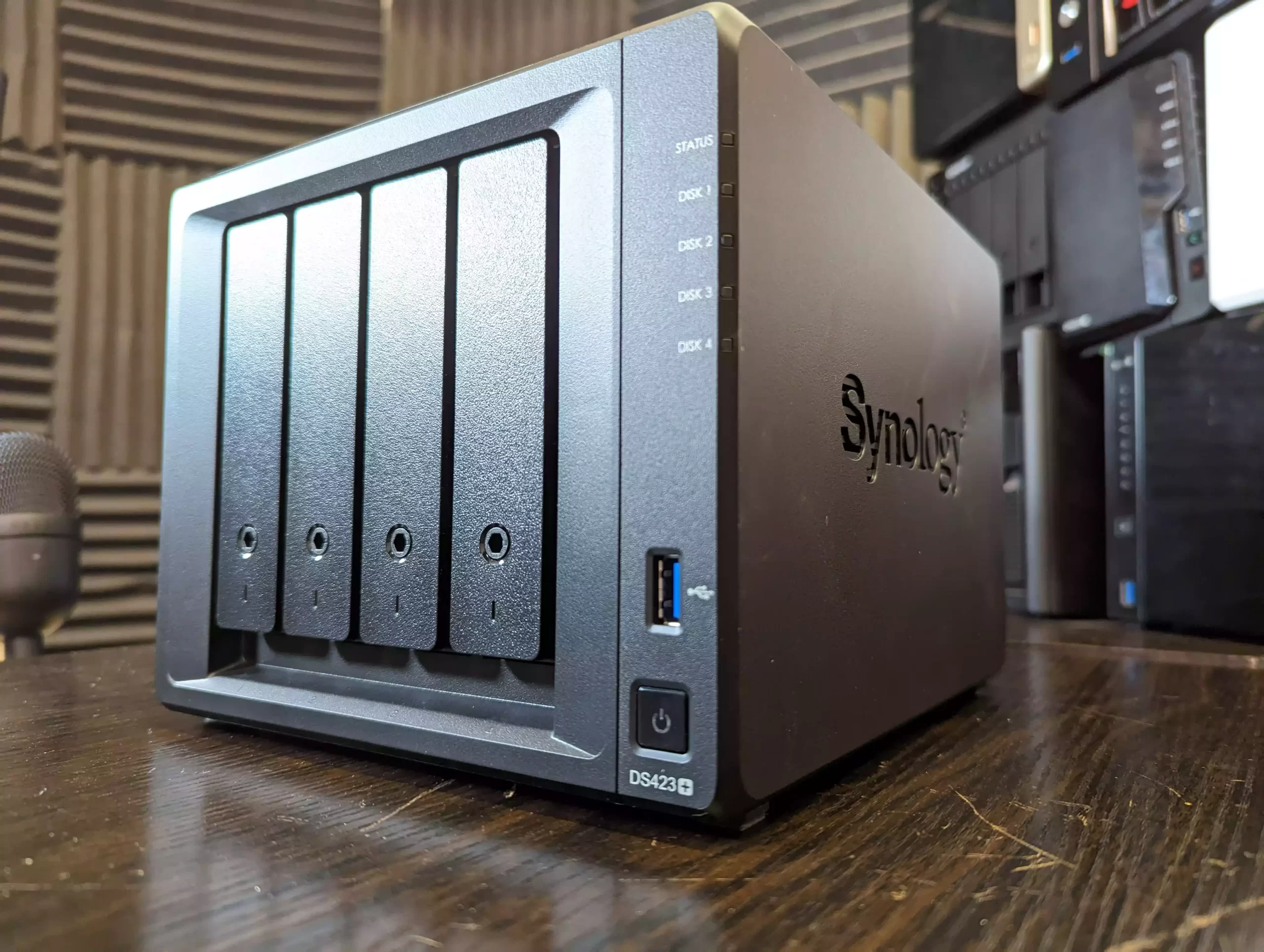
Synology DS423+ NAS Review – Quick Conclusion
There are two ways we need to look at the Synology DS423+ NAS. In one way, the Synology DS423+ DOES support all of the features and services that users demanded in a fully-featured home/prosumer solution. It features an Intel Quad Core processor with embedded graphics, DDR4 memory, multiple gigabit ports, wide HDD/SSD compatibility and m.2 NVMe SSD support. These are all things popular and most certainly what users would want/expect in a fully featured home/prosumer solution (aka SOHO). Then, when you roll in DSM 7 and it’s enormous range of software and services, the DS423+ is an excellent NAS solution that counters a broad range of criticisms that were leveled at the DS923+ at launch. However, there is, of course, the unavoidable way that most long-term Synology users and those looking to upgrade an existing 2016/2018 Diskstation are going to look at the DS423+ – a Synology DS920+ with less memory and no expandability! For those that skipped the DSx20+ generation, the DS423+ is going to feel decidedly underwhelming at best and hugely disappointing at worst! Synology has made no bones that they prioritize their software and services, with hardware being an important but nevertheless secondary concern. The main criticism is that CPU being the same processor used in the 3 years previous generation. Intel has moved production away from the J4125 themselves several times (with most other NAS brands using the N5105 or J6412 right now) and although Synology has been known to move CPU architecture down through the generations previously, this is a particularly egregious example. If they had just scaled something up on this device, such as the network ports from 1GbE to 2.5GbE, add the option of a 10GbE upgrade or more over upgrade the base level memory from 2GB or 4GB. The Synology DS423+ IS a good NAS system and serves as a great means to enjoy the wide-ranging features of DSM privately or professionally! It just feels like more of a stop-gap system in some places and one that existing DS920+ or DS420+ owners will skip.
Where to Buy a Product





![]()
![]()

VISIT RETAILER ➤






![]()
![]()

VISIT RETAILER ➤






![]()
![]()

VISIT RETAILER ➤






![]()
![]()

VISIT RETAILER ➤
 DEAL WATCH – Is It On Offer Right Now? DEAL WATCH – Is It On Offer Right Now?Synology 4-Bay DiskStation DS423+ (Diskless) Amazon  USA 21.54 OFF (WAS 536) [LINK] USA 21.54 OFF (WAS 536) [LINK] These Offers are Checked Daily
|
Synology DS423+ NAS Review – Packaging
The presentation of the retail box does have more attention to detail than you might expect though (given this is a 99% online purchased device and therefore any glossy/detailed livery is almost a vanity addition!), as alongside the expected Synology logo and sticker for the model ID, the box is printed with tonnes of devices specific details. Synology has always been very, VERY aware of the power of branding with their solutions, as its little details like these (as well as embossed handles and favouring solution/every-man related terminology over cold specifications on the packaging) go a long way to set them apart from the sea of brown-box-rinse-repeat found in most online IT solutions you buy online and not at retail.
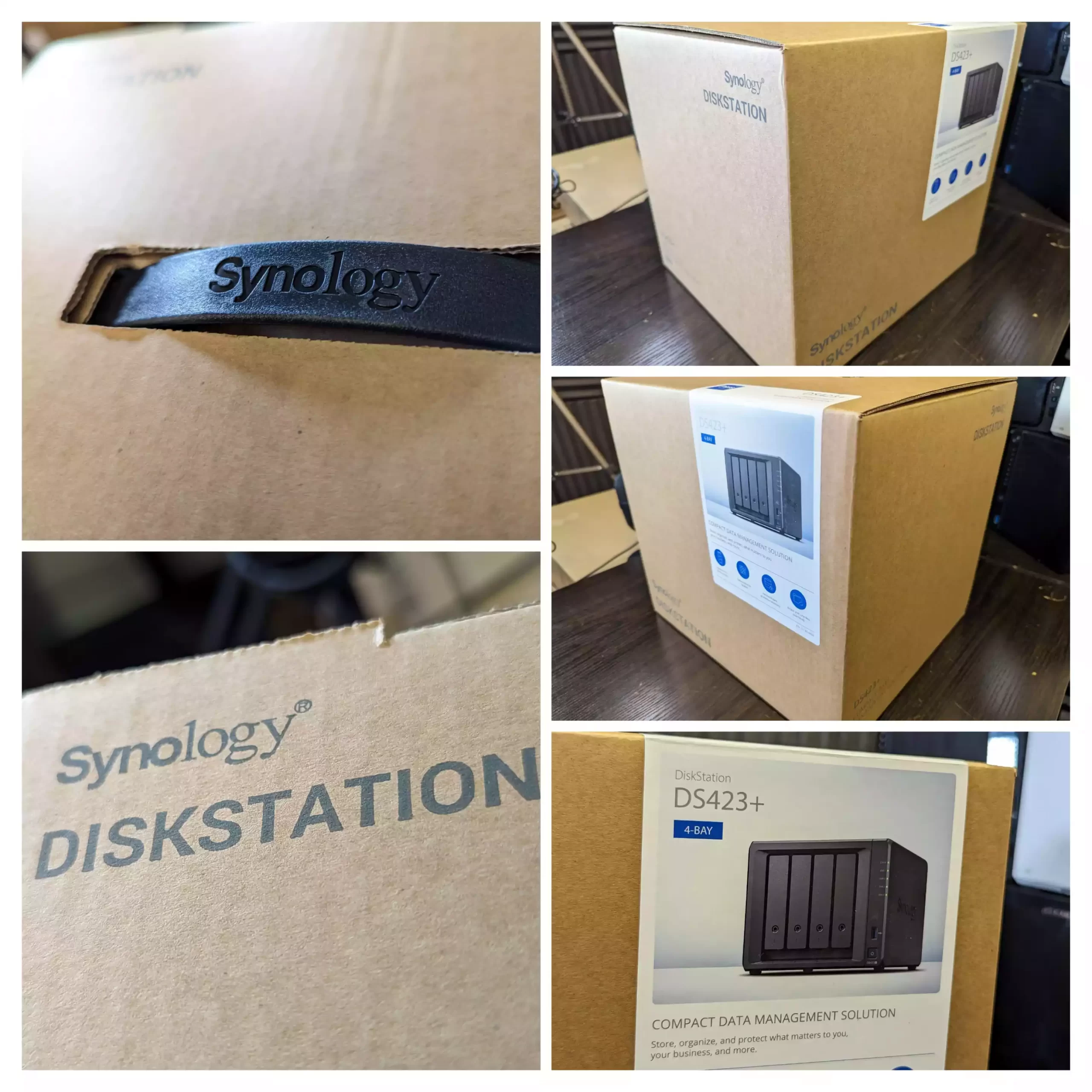
Despite the fact the DS423+ NAS is shipped unpopulated from Synology, we still need to grade/review them on the protection this unit is afforded in transit. As solid as a lot of IT kit looks, you cannot ignore the effects of shock or motion damage on them in long-distance travel from their point of manufacture (Taiwan in this case), so I will always give a brand extra points if they have gone the extra mile to spend a little more on protecting their system. In the case of the Synology DS423+ NAS, it’s mostly ok. I wish they used more hard foam/surrounding as you find in their 6-Bays and higher solutions (DS1621+, DS1821+, etc), as the DS423+ NAS arrives in a mostly cardboard structure that I think will be fine for the most part, but wouldn’t stand up to physical pressure tremendously well. Everything is separated very well and the structure/framework is there, it is just mostly cardboard! But I am being a bit petty here… let’s move on!
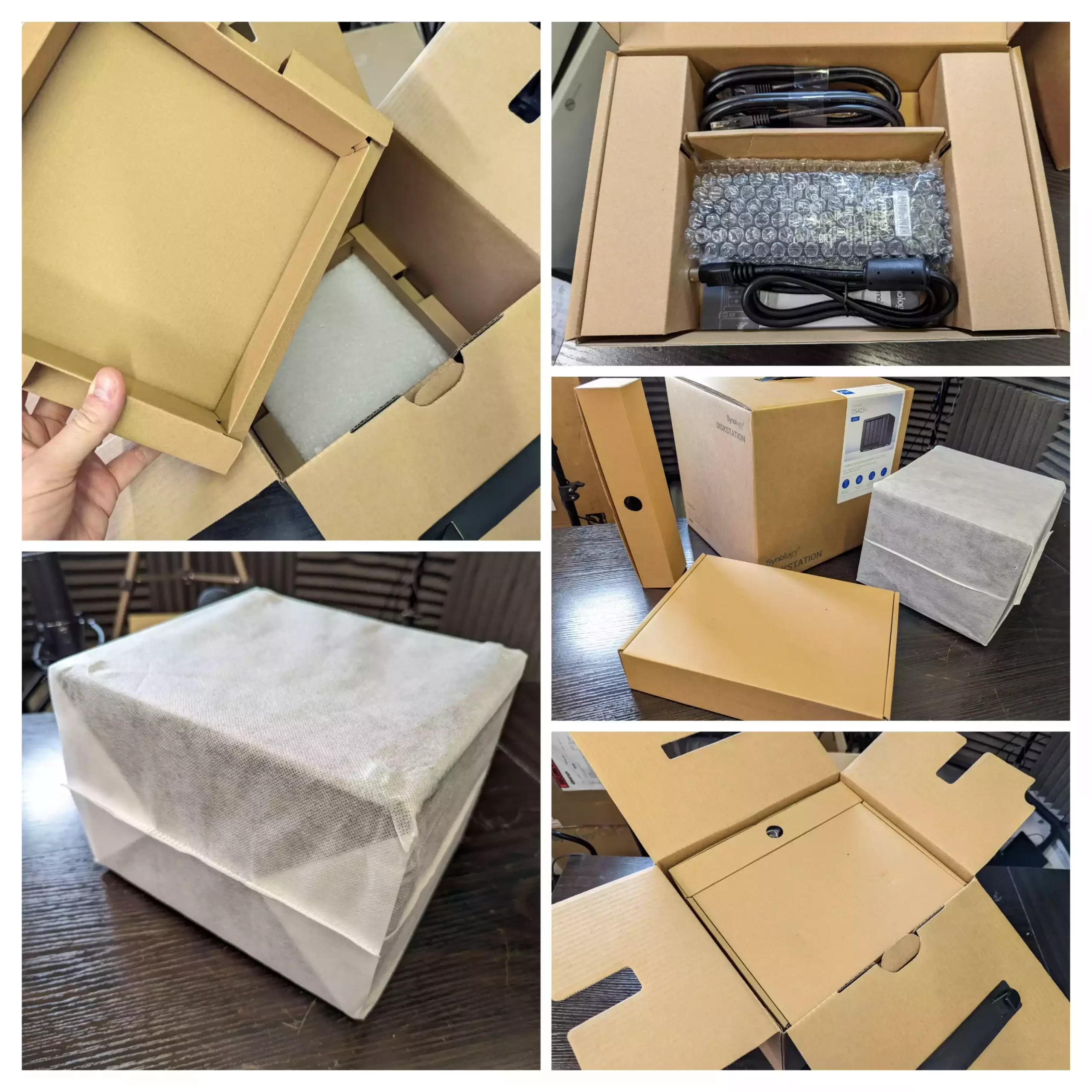
The DS423+ arrives with the accessories you would expect. The NAS unit itself, an external 90W PSU, Screws for 2.5″ media (3.5″ media installation is toolless), RJ45 Cat 5e ethernet cables, keys for the storage bays, first-time setup document and information on your warranty. All fairly standard stuff, though I am always surprised by the fact that Synology never include heatsinks for the M.2 NVMe SSD bays, given the high priority of the brand towards caching on these storage bays – something that can get those M.2 SSDs pretty hot.
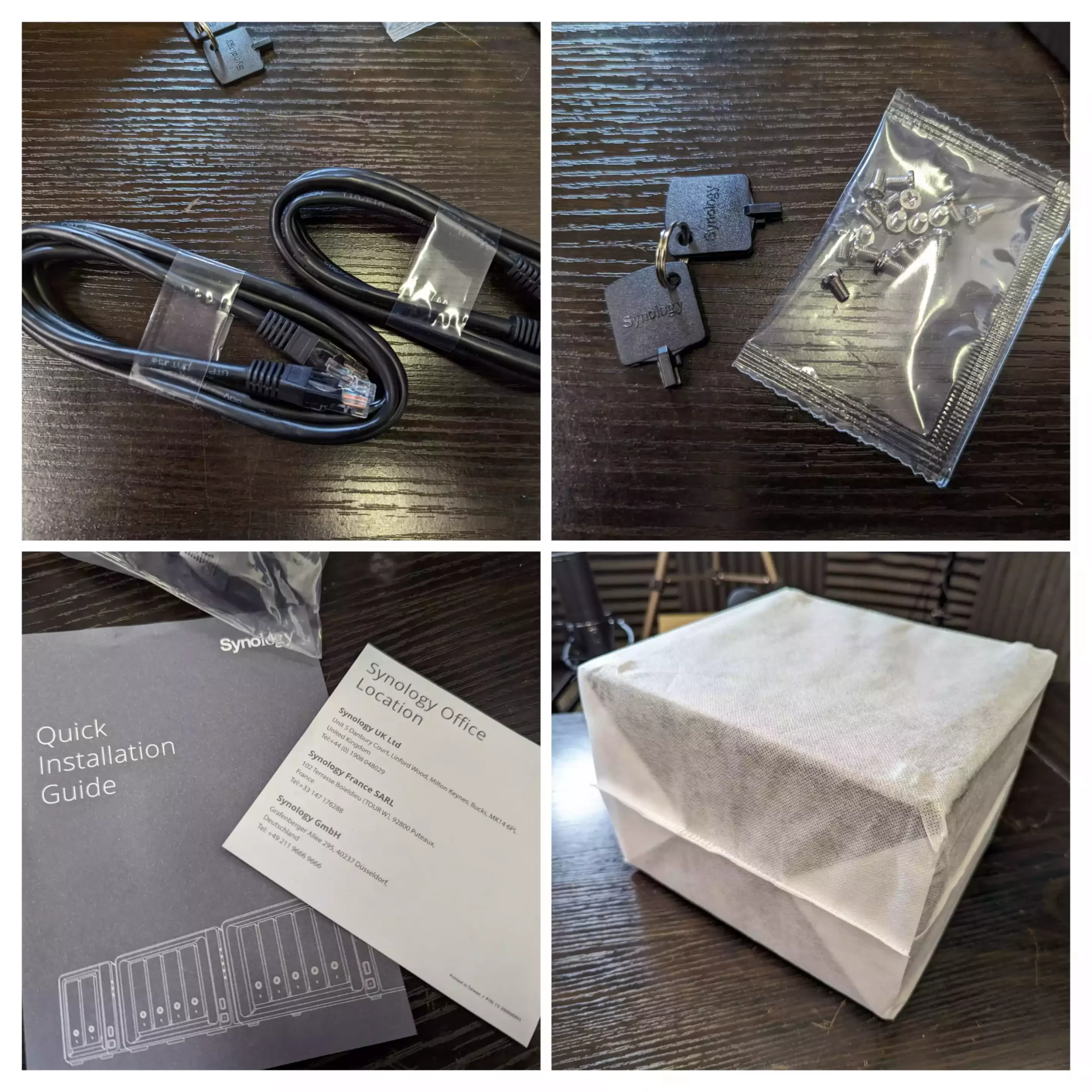
The external PSU is Synology branded, always a nice touch, and although there is a contingent of users that prefer an internal PSU (less fuss, tidier) I will always prefer an external power supplier, as it is hugely easier to replace, reduces the size of the NAS chassis itself and keeps those internal temps a little lower too. Luckily this NAS is such a low-impact model in terms of power use that a modest external power brick is completely possible.
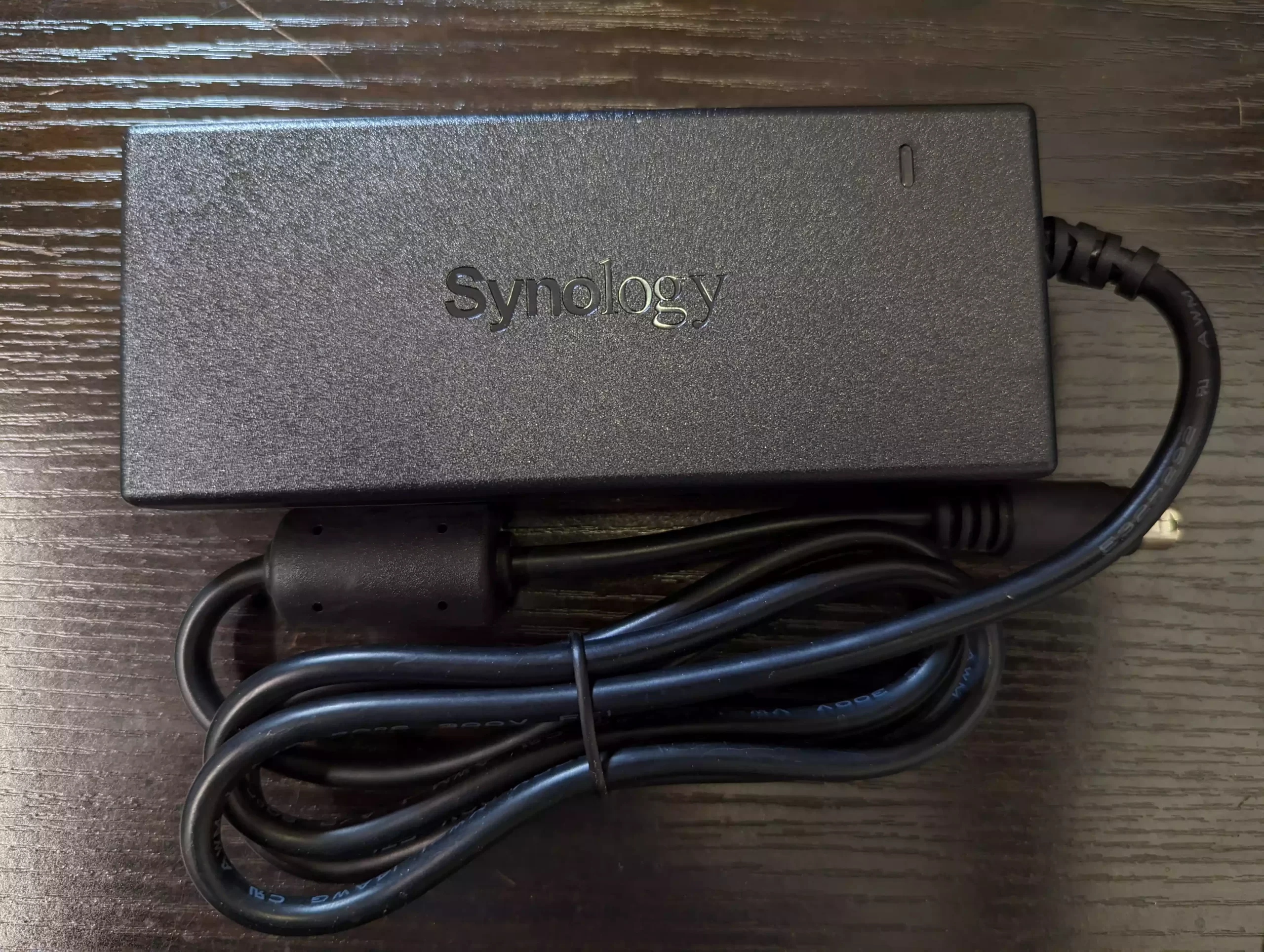
The retail kit for the Synology DS423+ NAS is all fairly standard stuff in contents, but still a very branded package and completely what we would have expected from this very brand-aware company! Let’s discuss the design of the DS423+.
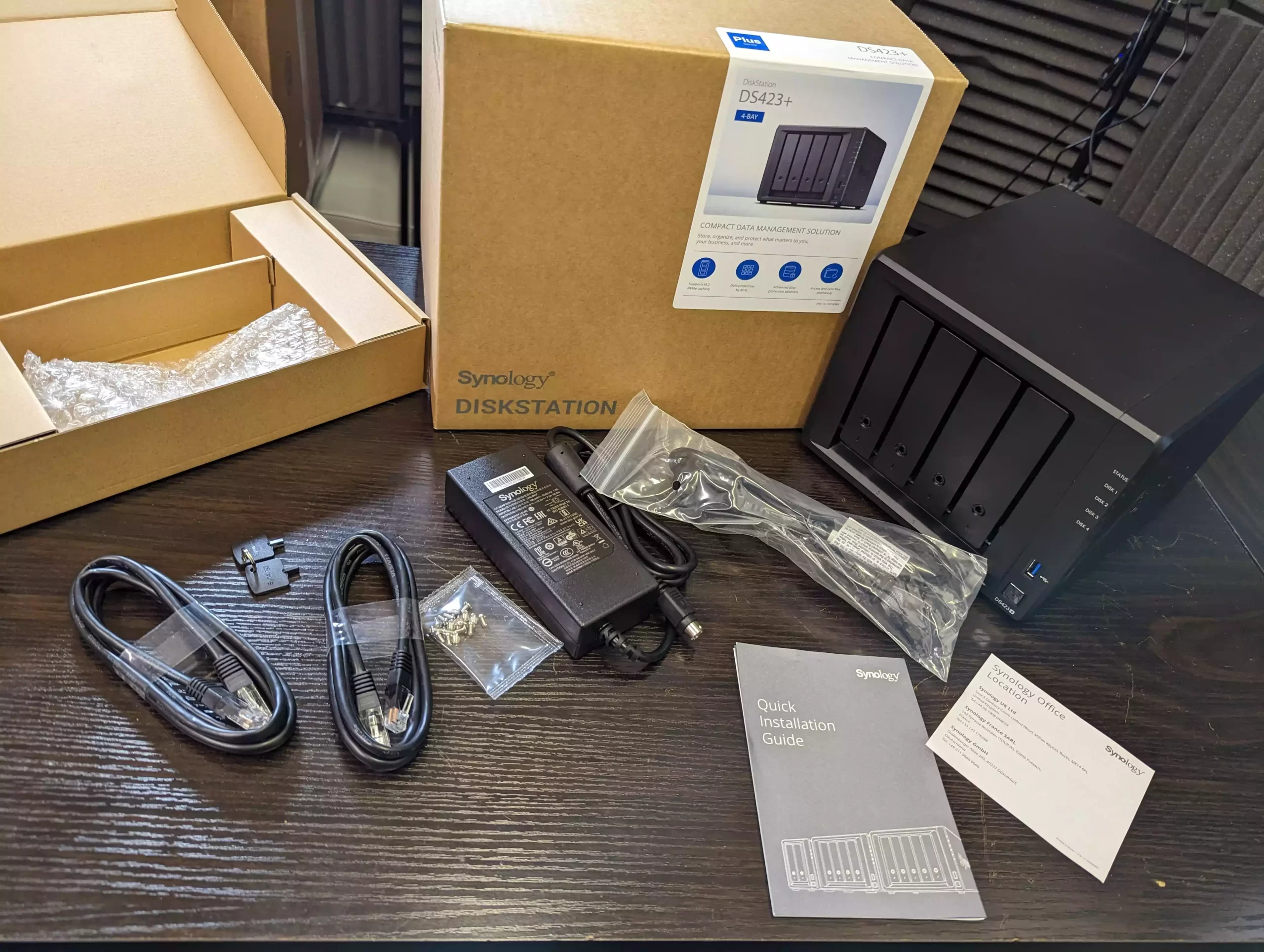
Synology DS423+ NAS Review – Design
As you might expect, the DS423+ Diskstation casing is identical to that of the DS920+ and DS918+ that came before it. This is a particularly well-designed device, both in terms of aesthetic design AND it’s efficient system operation 24×7, with tonnes of ventilation throughout and very structured component distribution. Also, the chassis is a largely plastic external casing in matt black, that contains a much smaller structure on aluminium internally. The result is a NAS that is pretty low noise when in operation (unless you use HDDs larger than around 10TB and/or enterprise-grade 7200RPM disks). That said, one consistent vibe you get in the design of the DS423+ is that direct/physical interaction with the device is kept to a minimum, preferring almost entirely network/internet-based interactivity. Not a huge surprise for a ‘NAS’ of course, but there are a handful of physical attributes that are intentionally absent here. The front of the chassis lacks any kind of LCD display, instead favouring LED indicators. The bulk of the front panel is occupied by the main storage bays and these have alining of ventilation all around them to act as passive airflow.
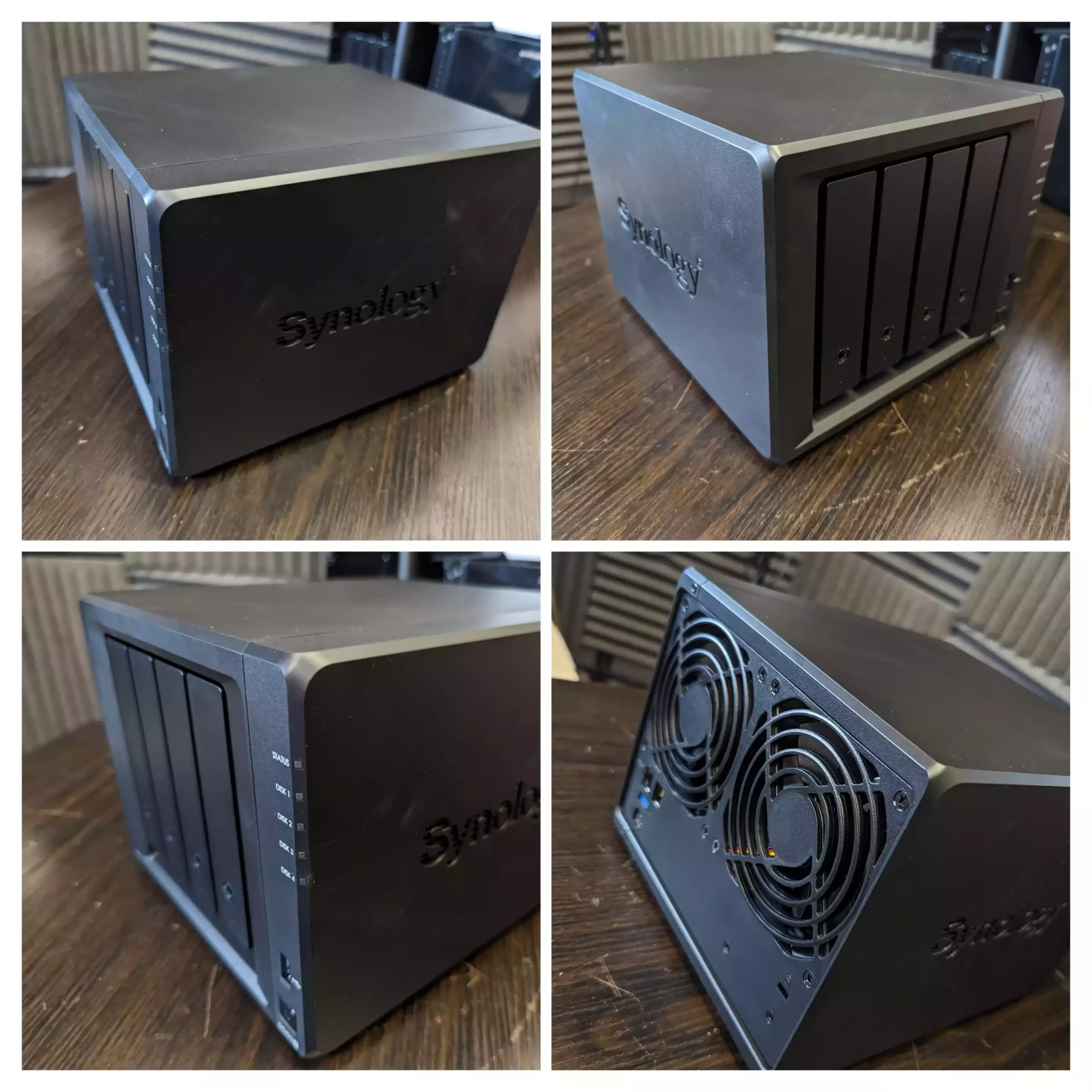
Passive airflow is definitely a big focus on the design of this chassis, with almost every side of the case featuring ventilation of one sort of around, with the Synology logo being vented. As this system will be in operation 24×7, it is heavily reliant on the rear fans to push air effectively through the system and over the assortment of internal heatsinks as effectively as possible and this chassis does that very well indeed. The Diskstation series at the 2/4 Bay level has always done a great job of melding modern design with necessary system temperature management and the DS423+ is no exception.
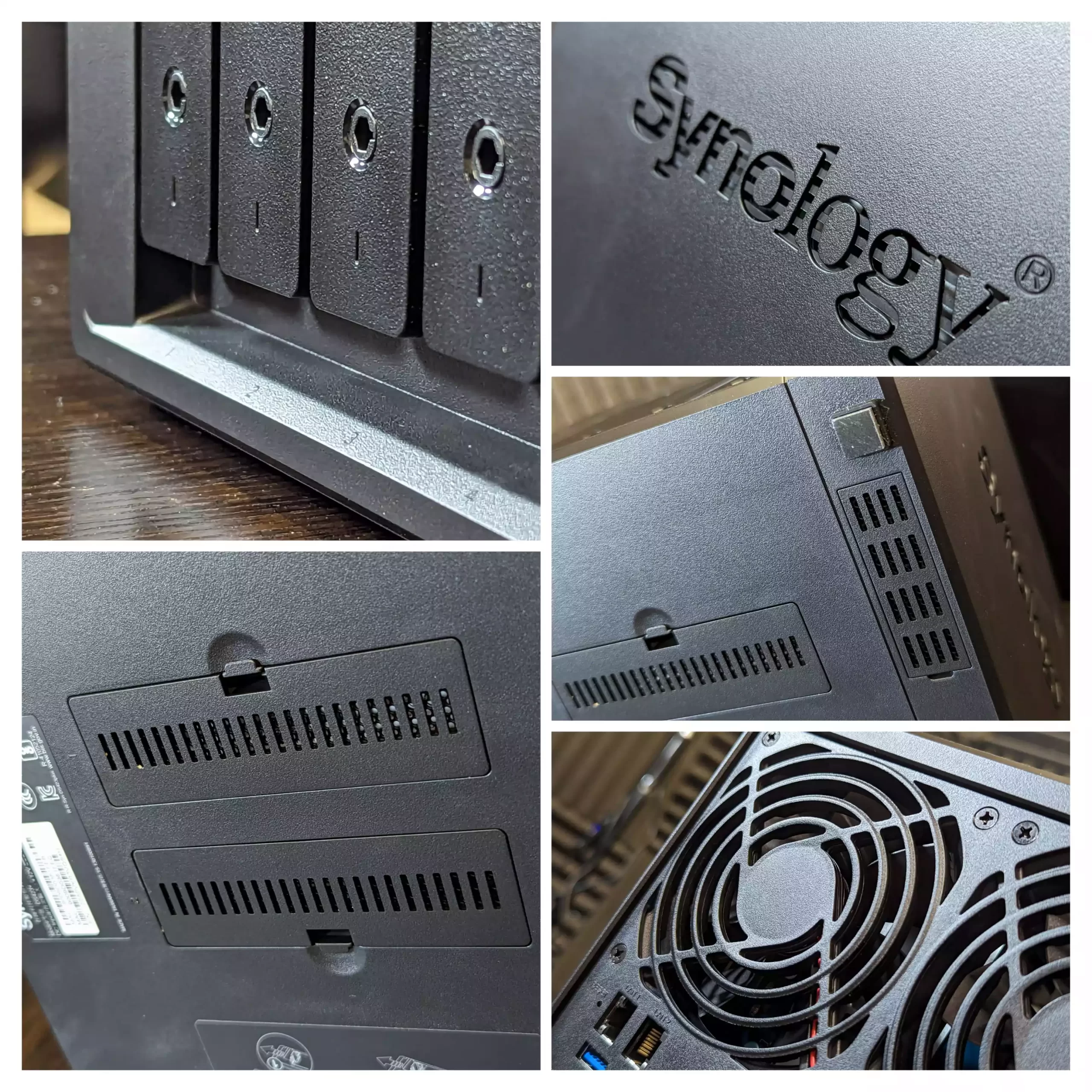
The LEDs on the front of the system use the usual three-colour system to denote drive activity and system status (network activity is absent, but the usual LEDs on the RJ45/Ethernet ports themselves are still present). These can have their brightness adjusted (or deactivated entirely) and although lack alot of the more information abilities of an LCD panel (IP addresses, system temp, alert description), they still serve ok as an initial indicator of system activity.
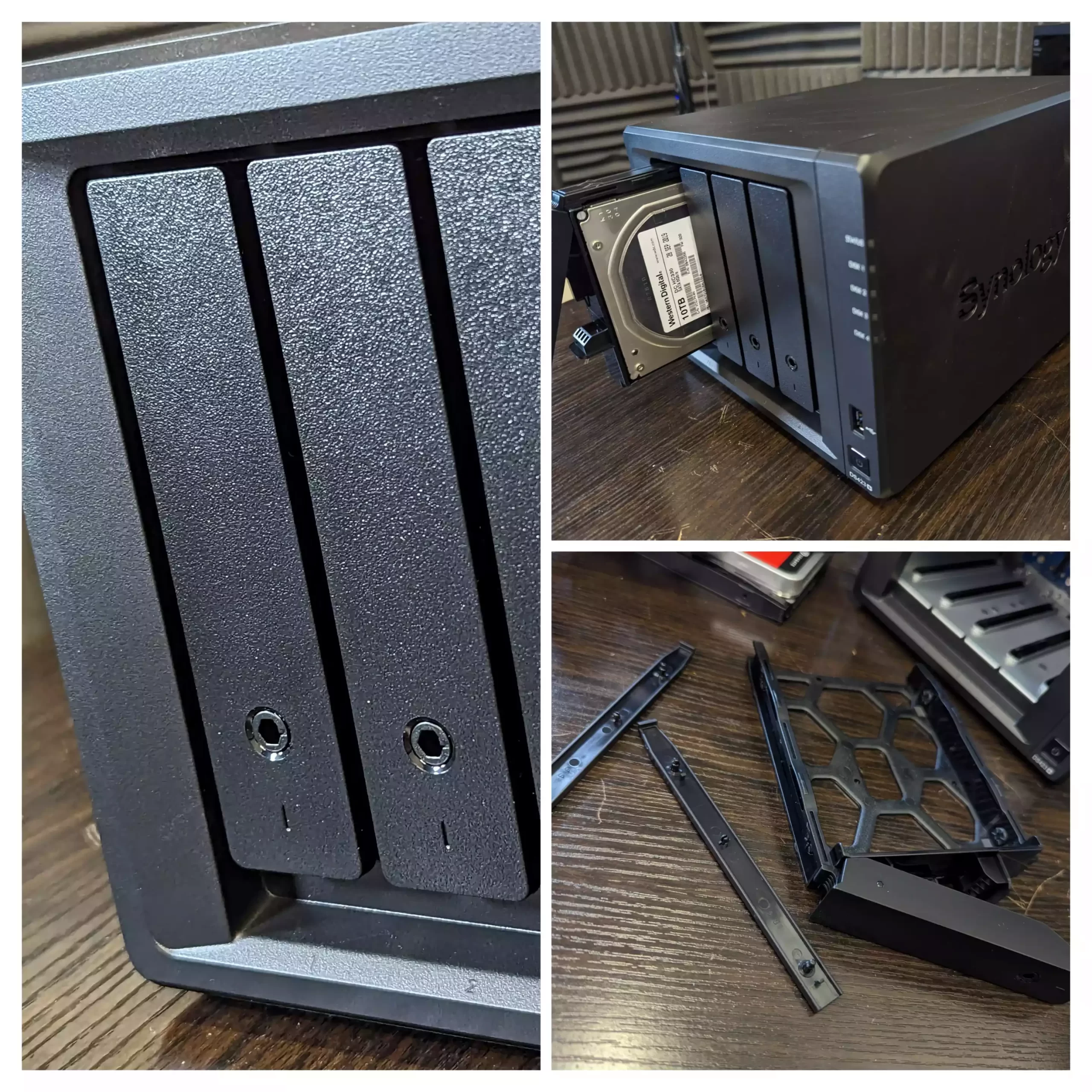
The main four storage bays of the DS423+ NAS are SATA interfaces and can be fully or partially populated with 2.5″ or 3.5″ media. The HDD/SSD compatibility of the DS423+ is still thinner than that of the DS920+, but Synology softened its stance a pinch on this subject after DSM 7.1 and the negative feedback on stricter HDD compatibility (i.e Synology media only), though drives above 18TB are still absent (at the time of writing) despite 20TB and 22TB hard drives being tested on the DS923+ and DS223 and working immediately.
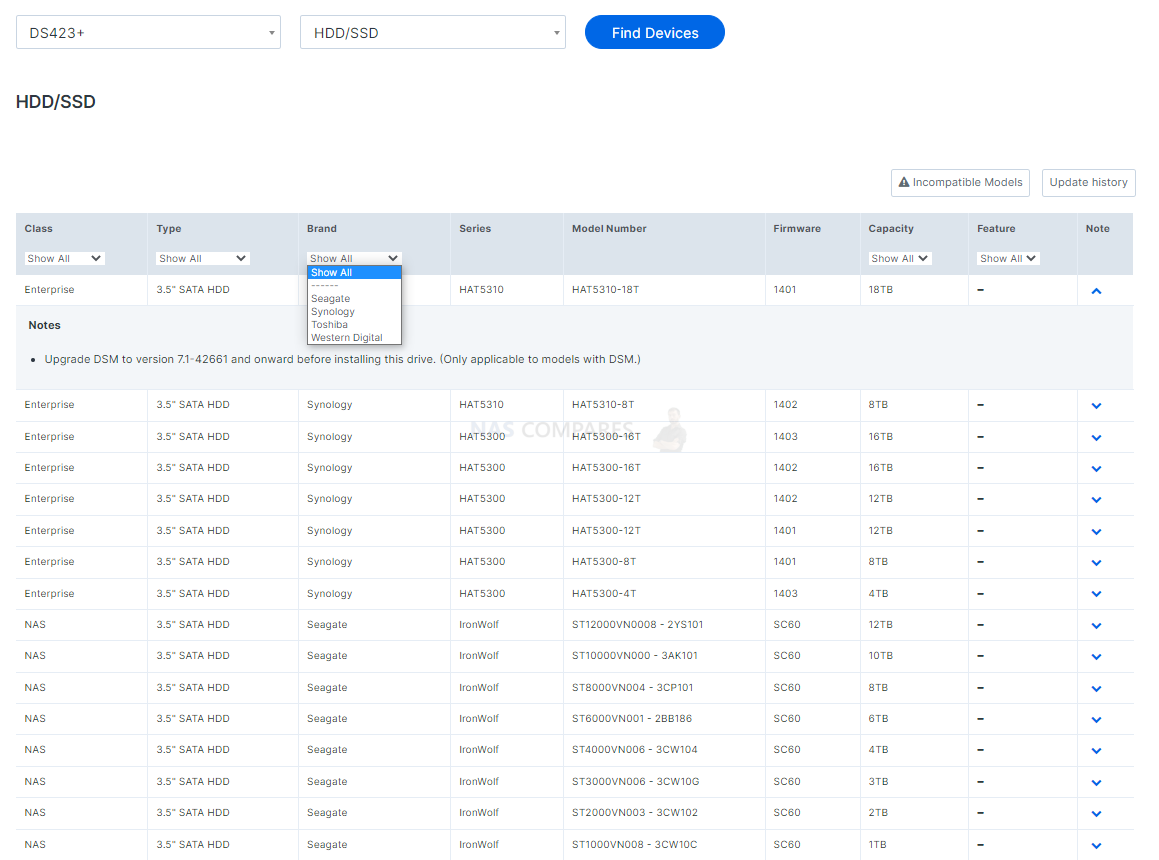
Then there is the soon to be arriving HAT3300 Synology/Seagate NAS HDDs coming soon that will most certainly be highlighted as a recommended choice for the DS423+ NAS. These four bays also allow you to use a large range of RAID configurations (redundant array of independent disks – a system of combining multiple drives to benefit storage scale, performance and/or data redundancy/safety-net). The usual configurations are here, RAID 0, RAID 1, RAID 5 and RAID 6, but the system also supports Synology’s Hybrid RAID (SHR) which allows you to mix different HDD/SSD capacities. It’s pretty unlikely that you will mix drive media on day 1, but if you partially populate or want to upgrade your drives gradually a few years down the line, SHR is SIGNIFICANTLY easier to expand and absorb newer/larger drives into an existing RAID. That said, the performance of SHR is a pinch lower than RAID 5, so for those hoping to take advantage of the 10GbE connectivity might do well to think about their Day 1 RAID and it’s impact down the line.
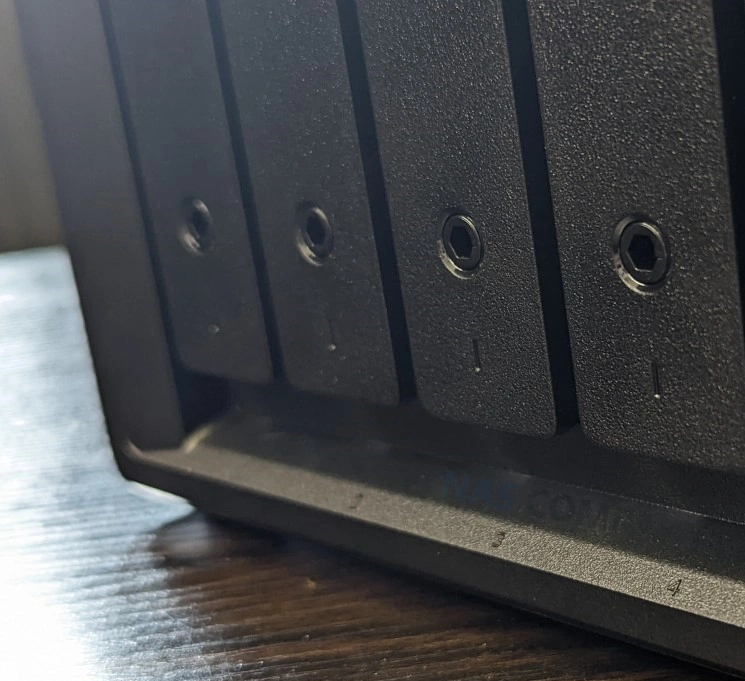
The trays themselves are plastic click-n-load tracks that feature a locking mechanism. It’s worth highlighting that this lock is by no means ‘industrial’ and removing a drive is going to be easy for particularly nefarious individuals, but this lock is more to prevent accidental removal than it is as a meaningful security barrier. The trays have screw holes for 2.5″ media to be installed with screws, but 3.5″ media is installed in seconds with the use of side clips that hold the drive in place via it’s own fixtures. The plastic tray is pretty sturdy and heat/cracking is not going to be any concern here. Also, the plastic trays will lower the ambient noise level when in operation more than metal trays would do, but (sorry to be repetitious) if you use bigger than 10TB HDDs, it is simply not possible to reduce the clicks, hums and whurs of these more industrial drives.
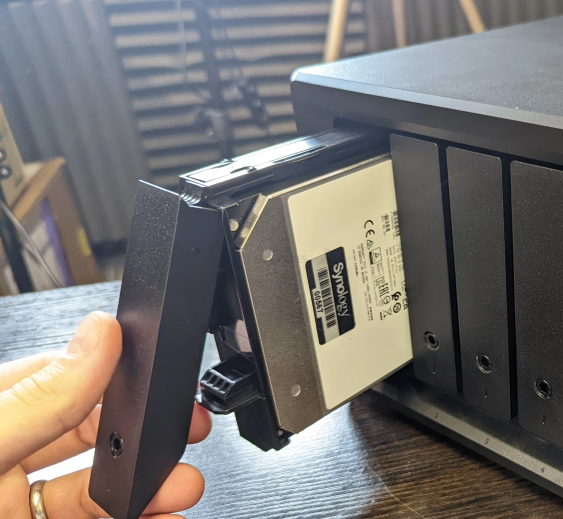
The front of the DS423+ NAS also features a USB port that can be used for connecting an external drive for backups in either direction (i. backup the drive contents to the NAS, or present files and folders to the NAS to the drive). Now, the DS423+ does not feature a front-mounted copy button (bit annoying) but DSM does include a USB copy tool that allows drives to automatically trigger a pre-set USB-to-NAS or NAS-to-USB operation when a drive is connected, which is pretty detailed in its setup (pre-set directories, age of files, exclusions, schedules, versioning, etc).
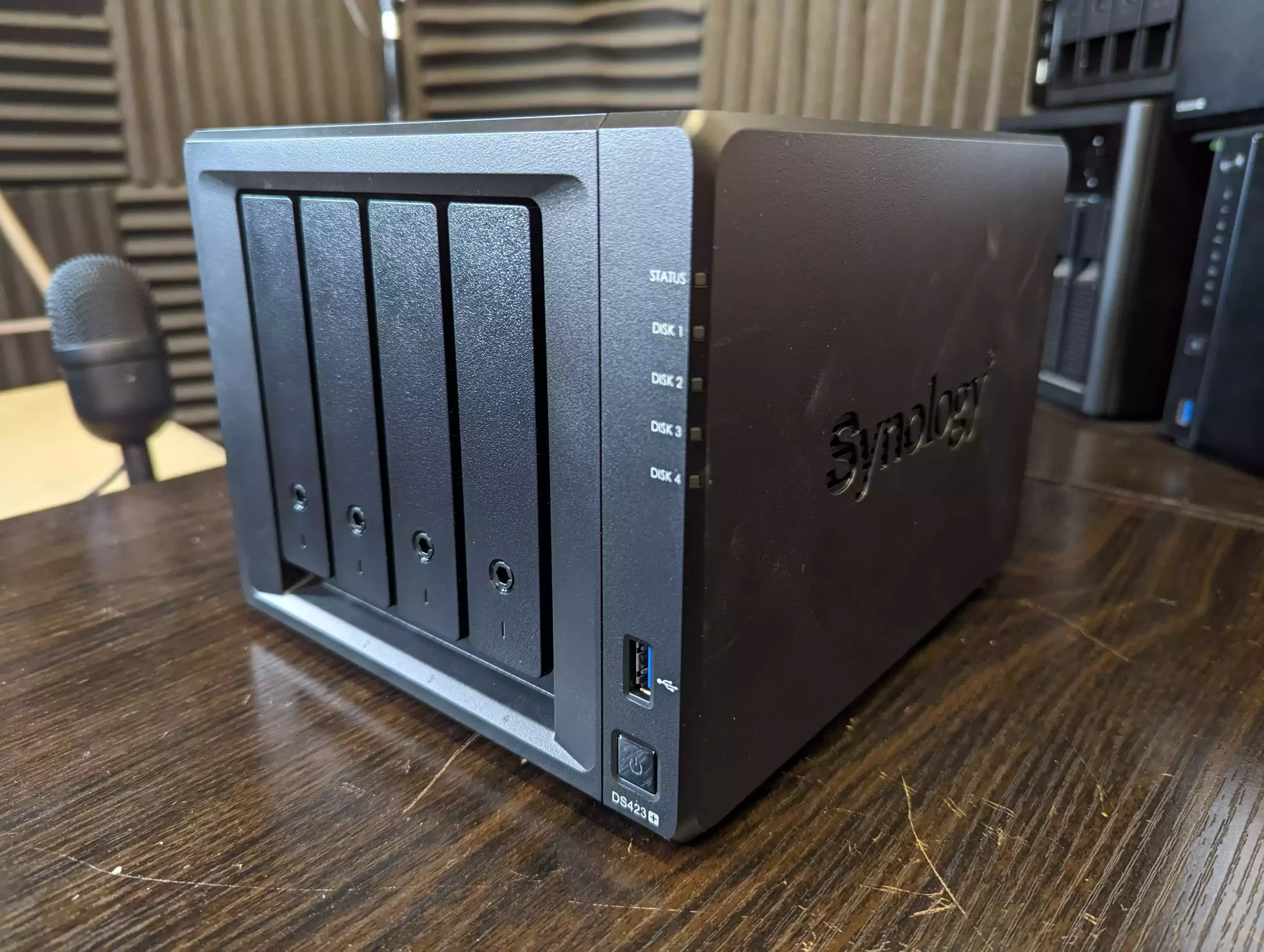
Looking at the base of the DS423+ NAS shows us those two m.2 NVMe 2280 SSD slots, each with a ventilated top panel. These two slots support a PCIe Gen 2 SSD in each bay (which can be partially/fully populated) in order to take advantage of SSD caching in the Synology storage system. Caching can consist of Read Caching (when more frequently accessed data is copied to the faster SSD to allow faster retrieval later, though the benefits are only really felt/observed in smaller data) and Write Caching (When data being uploaded/sent to the NAS is initially written to the SSDs and then moved to the internal larger/slower HDD RAID array).
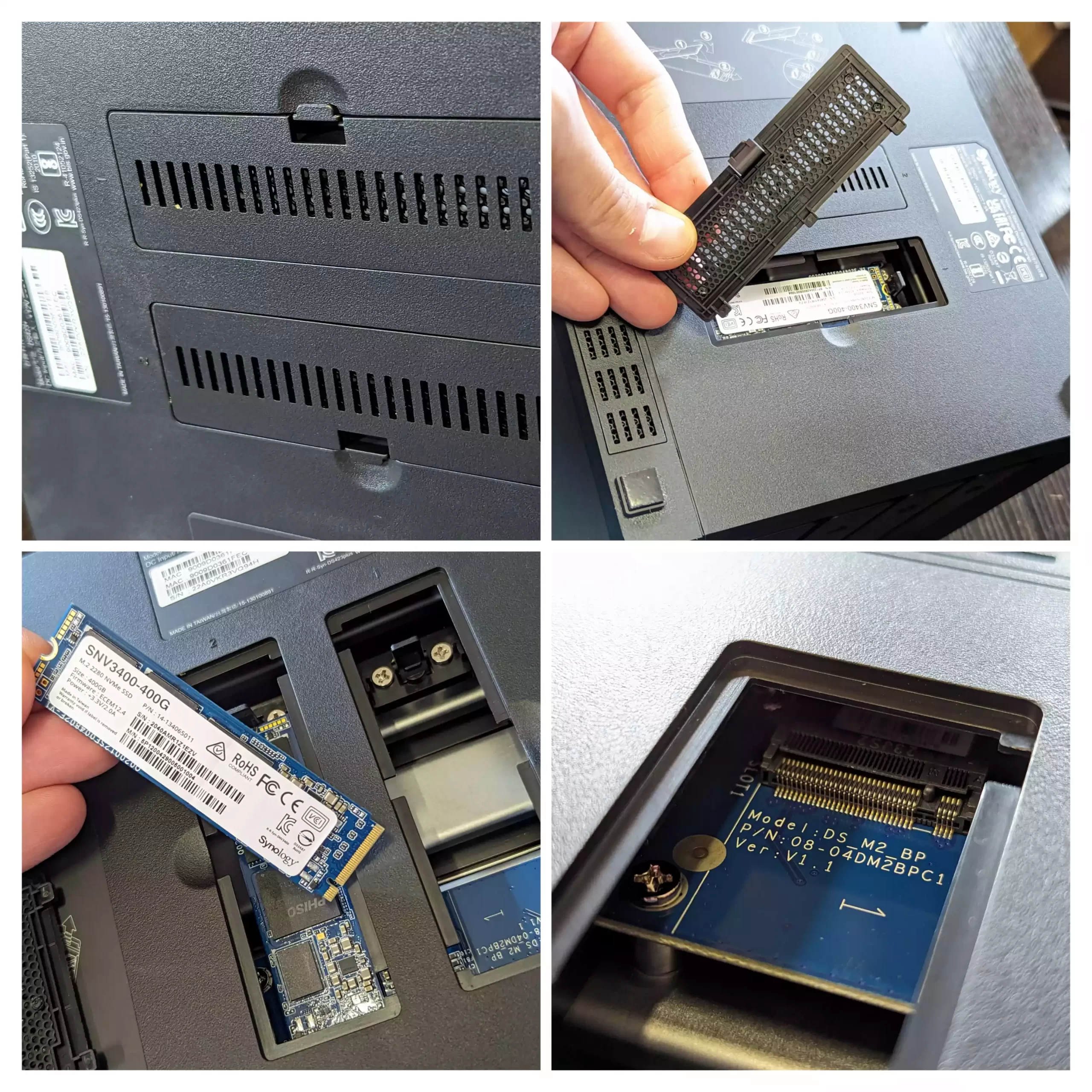
Alongside caching, these bays also support use as independent storage pools (a feature beginning to appear on more and more Synology NAS systems). At the time of writing, you cannot initialize the DS423+ and DSM to run directly from these faster drives, though you CAN choose to install individual applications on the NVMe SSD Storage pool after initialization. You can even go a little off-piste and use one bay for Read caching and the other for a storage pool if you choose – quite nice for a 4-Bay SATA NAS to technically have 6 usable storage bays total. Space is a little tight, but there is certainly room for a couple of M.2 $8-10 heatsinks (I successfully tested the Eluteng Dual Design M.2 Heatsinks found HERE on Amazon) and definitely recommend heatsinks for drives in these bays, regardless of their use for caching and/or pools. There is the lingering question of the utility of these NVMe SSD bays for pools if the system only has 1/2GbE network connectivity (lacking any official means to scale up to 10GbE etc), but there is still plenty of room for their use for VMs, high quantity/low volume data bases and for particularly ‘hot’ data internally.
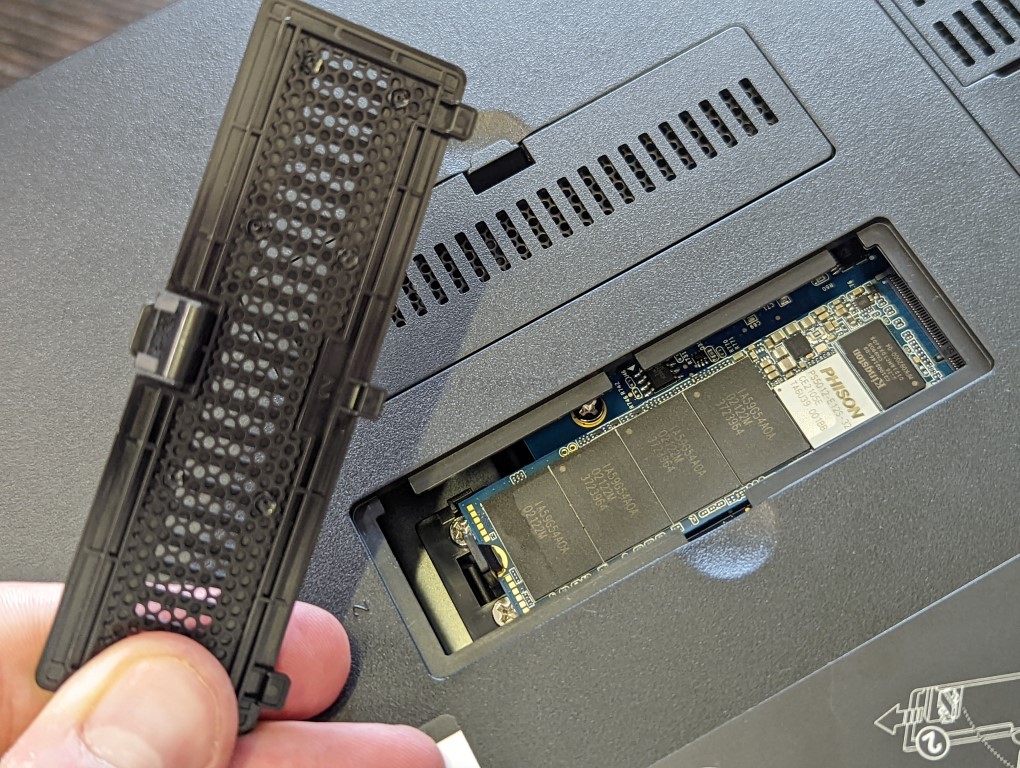
I have always been a big fan of the Synology Diskstation chassis for it’s minimalistic, yet attractive and efficient design. The absence of a USB copy button still irks me a little and the largely plastic design is not going to be to everyone’s taste, but you cannot fault the amount of R&D that has gone into the construction here. Let’s discuss the ports and connectivity of the DS423+ NAS.
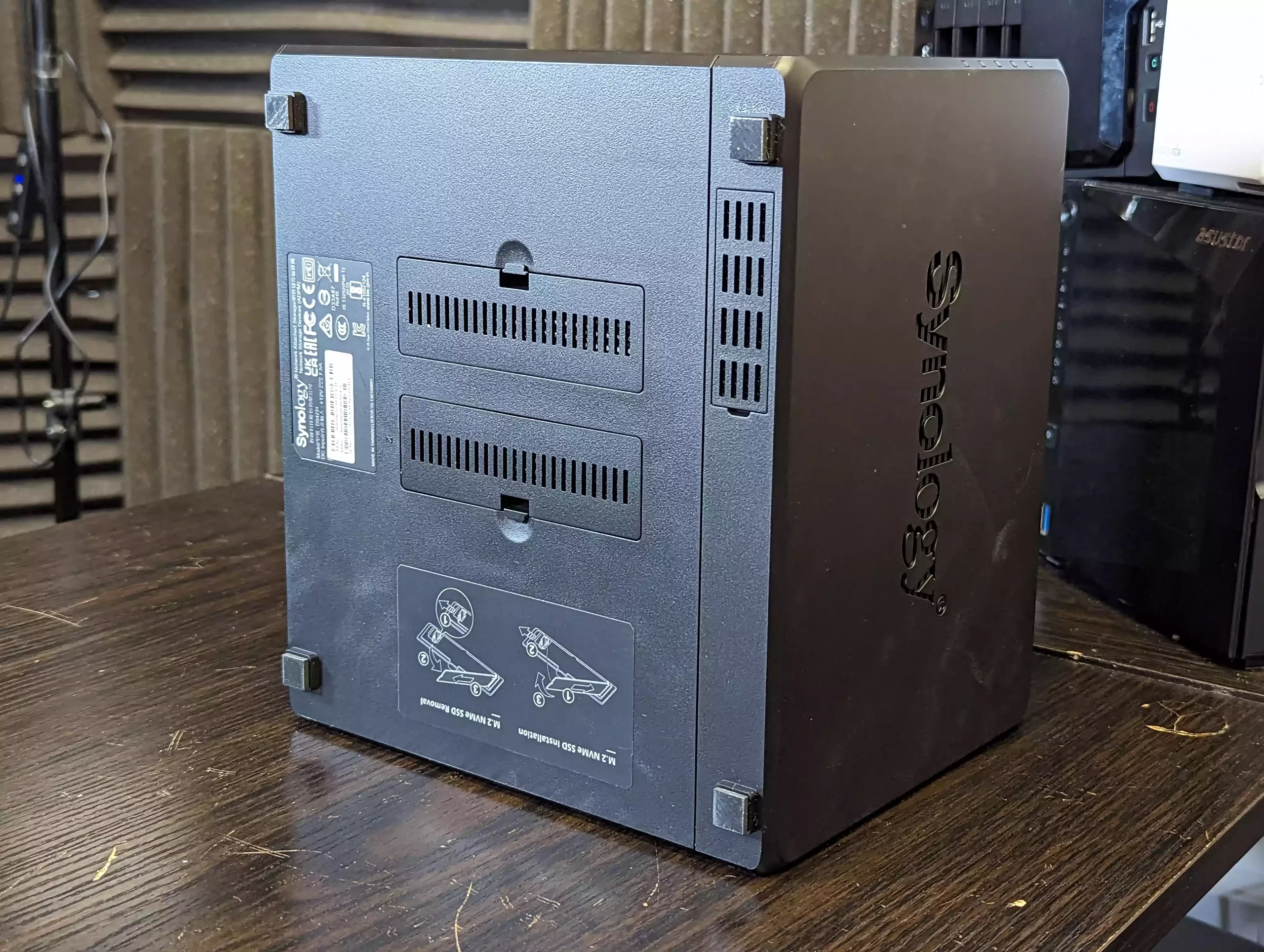
Synology DS423+ NAS Review – Ports and Connections
The ports and connections available on the Synology DS423+ NAS are not a huge leap from those found on the DS420+ and DS920+ that came before it (in fact, they are pretty much identical to the DS420+) and the rear is largely dominated by the 2x 92mm fans
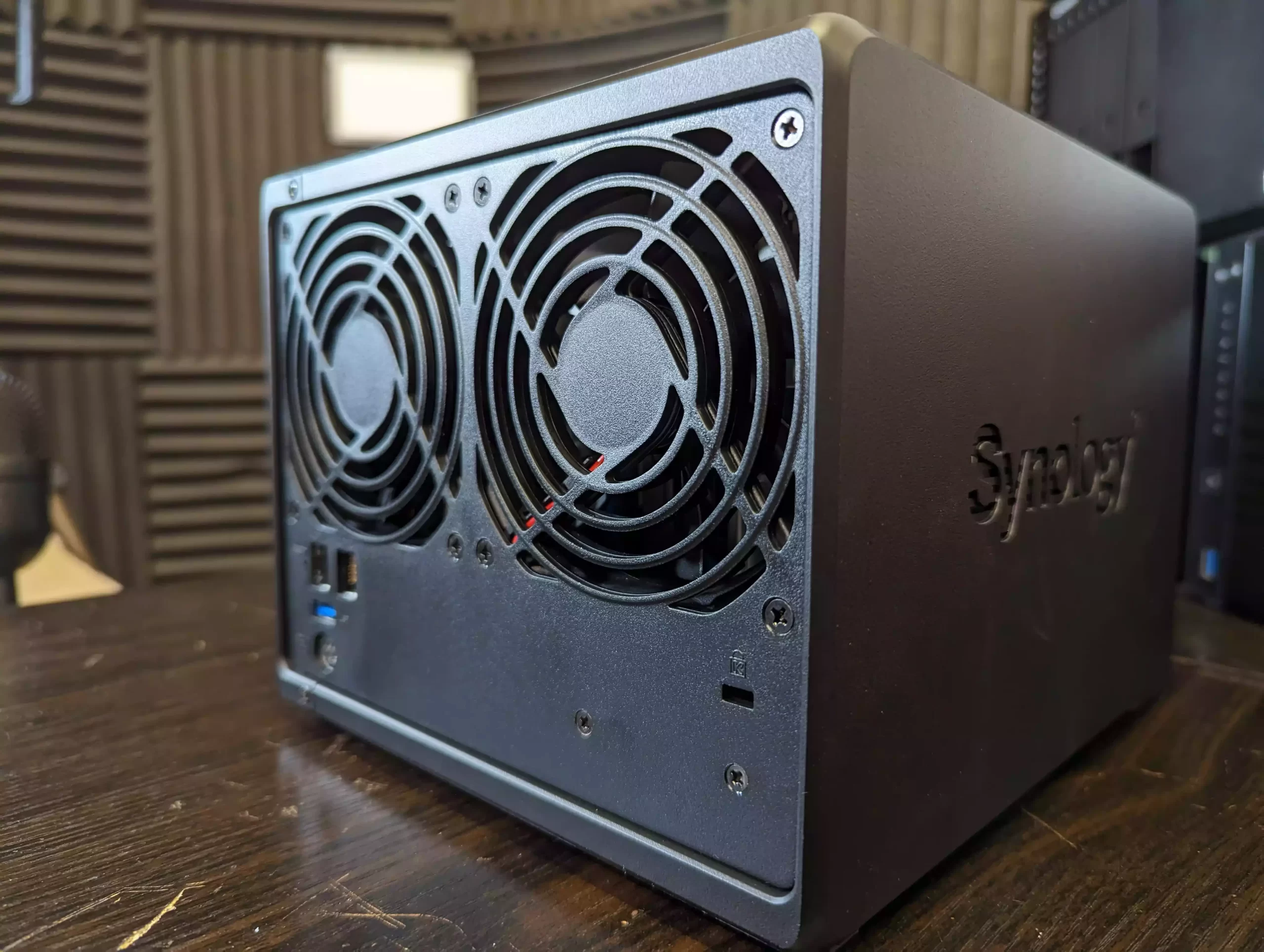
These two active cooling fans that will automatically adjust their RPM as the system’s ambient temperature requires. You can adjust these manually if you are especially noise-sensitive, but I would really recommend it (a low system temp = better system efficiency). The fans are not removable (built into the back panel of the system), so cleaning and maintenance are a little fiddly, but thanks to the large amount of ventilation afforded to the system, this is not really an issue long-term.
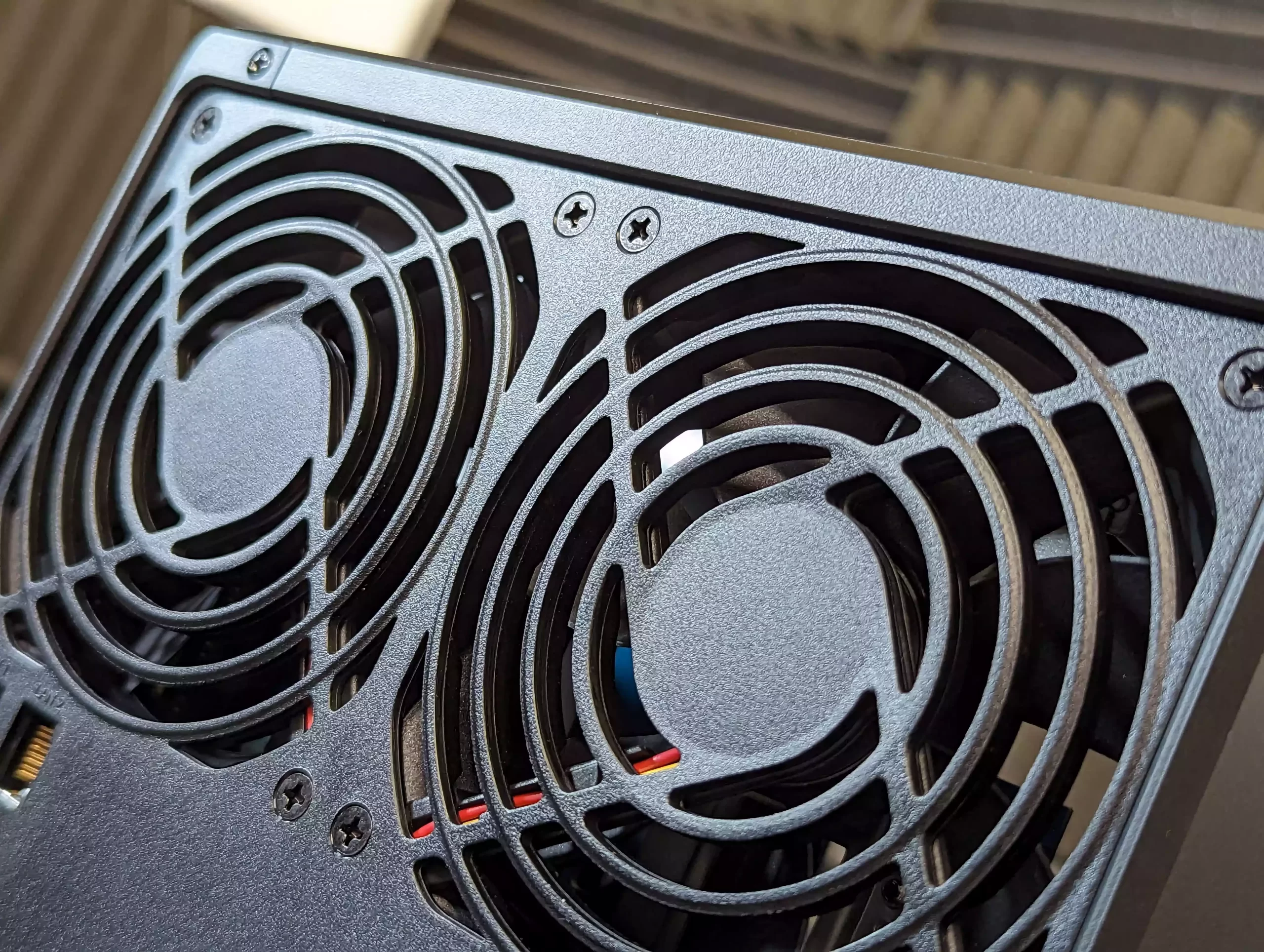
Let’s get the elephant in the room out of the way early doors! Those ethernet ports. The default model of the DS423+ NAS arrives with two-gigabit ethernet ports (the same as the DS920+, DS918+ and DS916+ before it), despite almost other commercial NAS brand producing solutions at this consumer-tier/scale arriving with at least 2.5GbE. Now, the adoption of greater than gigabit connectivity in client hardware (laptops, PCs, routers, switches, docking stations, etc) is by no means as ubiquitous as 1GbE (which has been around for decades at this point), BUT it is growing. ISPs are providing fiber internet connections globally that exceed gigabit speeds, along with 2.5GbE and WiFi 6 routers. We are seeing more prosumer switches, routers and PCs with default 2.5Gb network ports (at the same/similar cost as 1GbE), $20 USB-to-2.5G adapters and even the affordability of 10GbE on some client devices has allowed users to gradually scale up their hardware environment. The fact the DS423+ arrives at the tail end of 2023 and does not feature greater than 1GbE ports by default is quite damning. Even if you have no plans for 2.5G right now in your setup and think it something of a fad (favouring 10GbE), in terms of future-proofing and the general standard or networking hardware right now, gigabit ethernet is a surprising weakness here. This weakness in network connectivity is further highlighted when you consider that the winter 2022/2023 released DS923+ and DS723+ both arrive with the option to upgrade them to 10GbE with the E10G22-T1-mini adapter from Synology. Not having support of this adapter on the DS423+ feels like a big step back. Maybe with the Gen 2 CPU bottlenecking the bandwidth of the Gen 3×2 adapter too much – but then that begs the question of using the Gen 2 CPU at all! If Synology would hurry up and embrace 2.5GbE or at least sanction USB-to-2.5GbE adapters (hell – release their own branded one!), this would mitigate this somewhat.
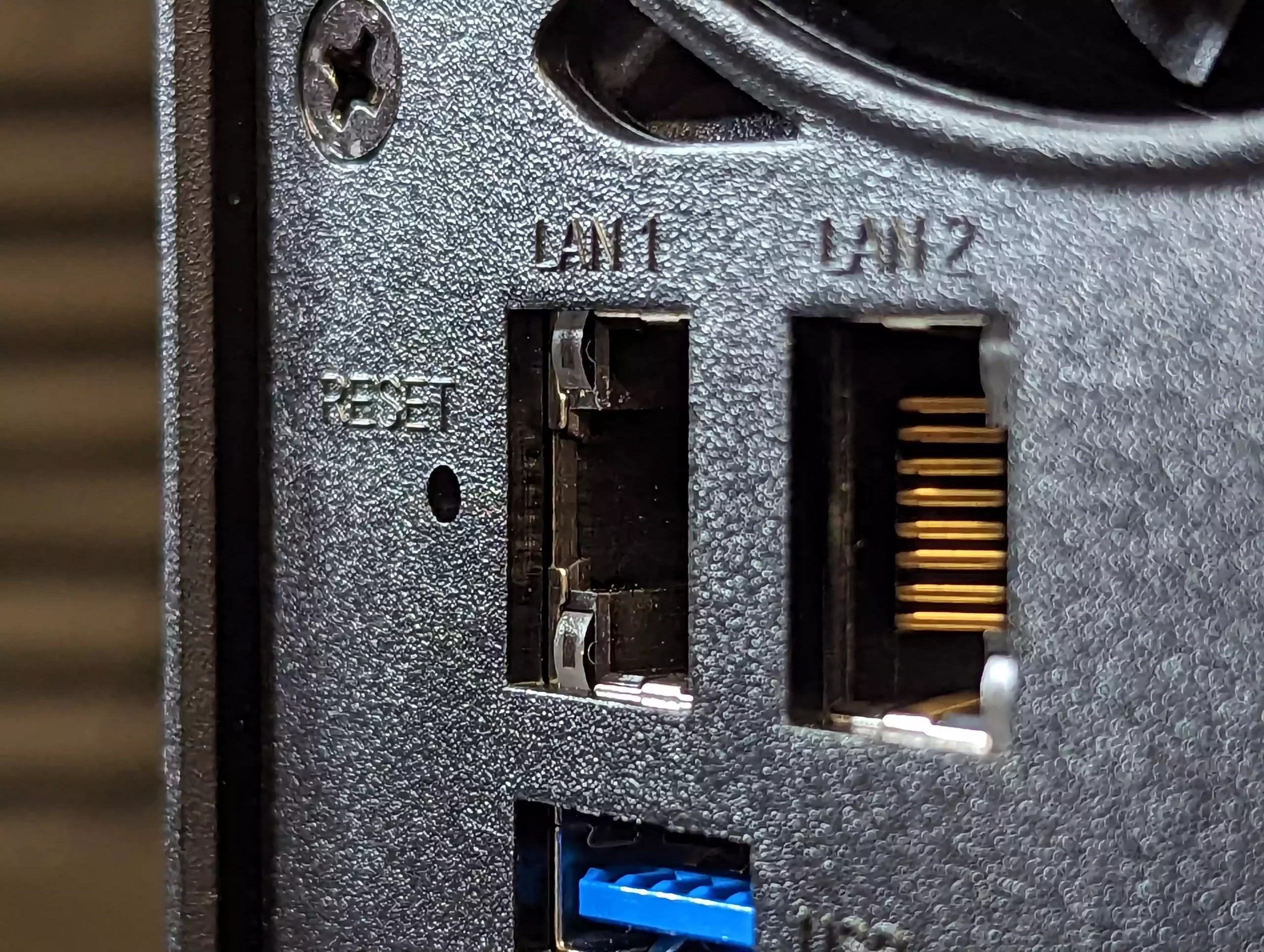
The DS423+ also have an additional USB Port on the rear and it is here that we should touch on another thing about the device that I am a little less blown away by. The USB ports here are USB 3.2 Gen 1, so 5Gb/s (500-500MB/s max bandwidth). Much like the 2.5G vs 1Gb complaints I made earlier, most other NAS brands at this hardware tier have rolled in USB 3.2 Gen 2 (10G / 1,000+ MB) ports, as well as USB-C in some cases. With the ease with which a user can add a USB tier to their 3-2-1 backup strategy (allowing them to be a little more financially creative with a network/remote/cloud backup tier as well), the slightly old skool USB ports here are a little underwhelming. With significantly more affordable RAID-enabled USB solutions in the market and/or M.2 NVMe external USB drives arriving affordable to comfortably provide faster external storage for backups, this seems like a bit of a misstep by Synology to ignore. Also, DSM 7 and DSM 7.1 (with DSM 7.2 coming soon enough) have reduced the range of use of the USB ports of Synology NAS systems (removing many network adapters, DTV tuners, wireless dongles, office accessories such as printers, scanners and optical drives), and limiting them largely to storage, UPS’ and assigning them to VMs. I am sure Synology has done the market research and observed reduced utilization of USB on their systems to dictate this decision, but it seems to be another move by the brand to prioritize network/remote access only with their systems.
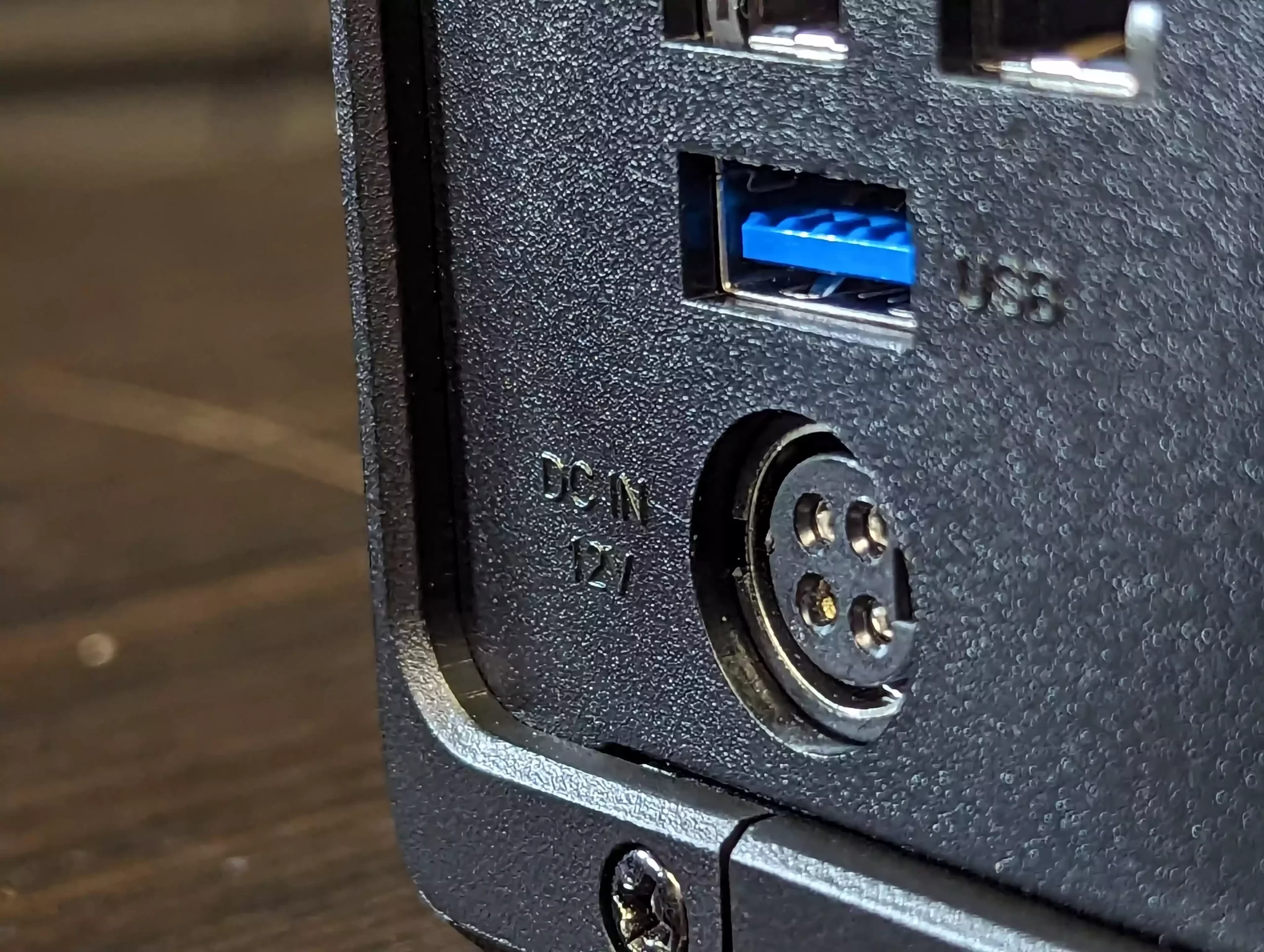
Overall the ports and connectivity of the DS423+ are technically no difference in the base model than the 2.5yrs older DS920+, just a lack of expandability via the DX517. Network connectivity and USB support remains exactly the same too, which is a little ‘meh’. Let’s take a closer look at the internal hardware and discuss the other big changes that the DS423+ brings over its predecessor.
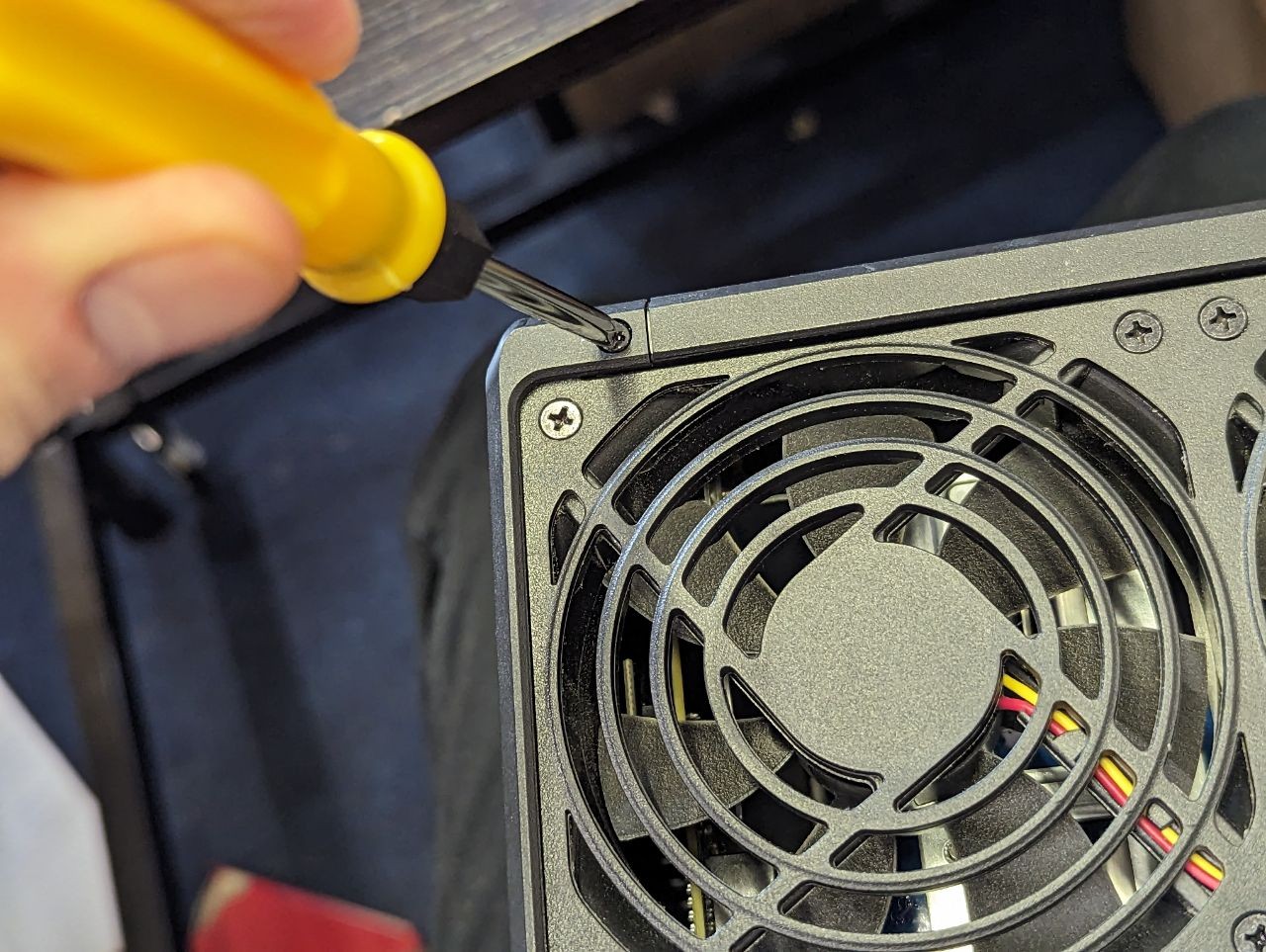
Synology DS423+ NAS Review – Internal Hardware
Most likely, the element of the DS423+ that people will be the most happy/annoyed about is the CPU. Arriving with the 2019/2020 generation Intel J4125 Celeron Processor, this 4 core 2.0Ghz processor can be burst to 2.7Ghz when needed and features UHD HD Graphics 600, so it has a great little transcoding engine on offer too. Surrounding this is an internal structure that is actually surprisingly light. This is not a criticism in the value sense, there is alot of airflow inside and you can see that ALOT of work has gone into the design of the DS423+ in order to keep it powerful, yet efficient. Everything is well spaced out and when there is crucial hardware, it is well deployed internally. Take the SATA bays inside for example.
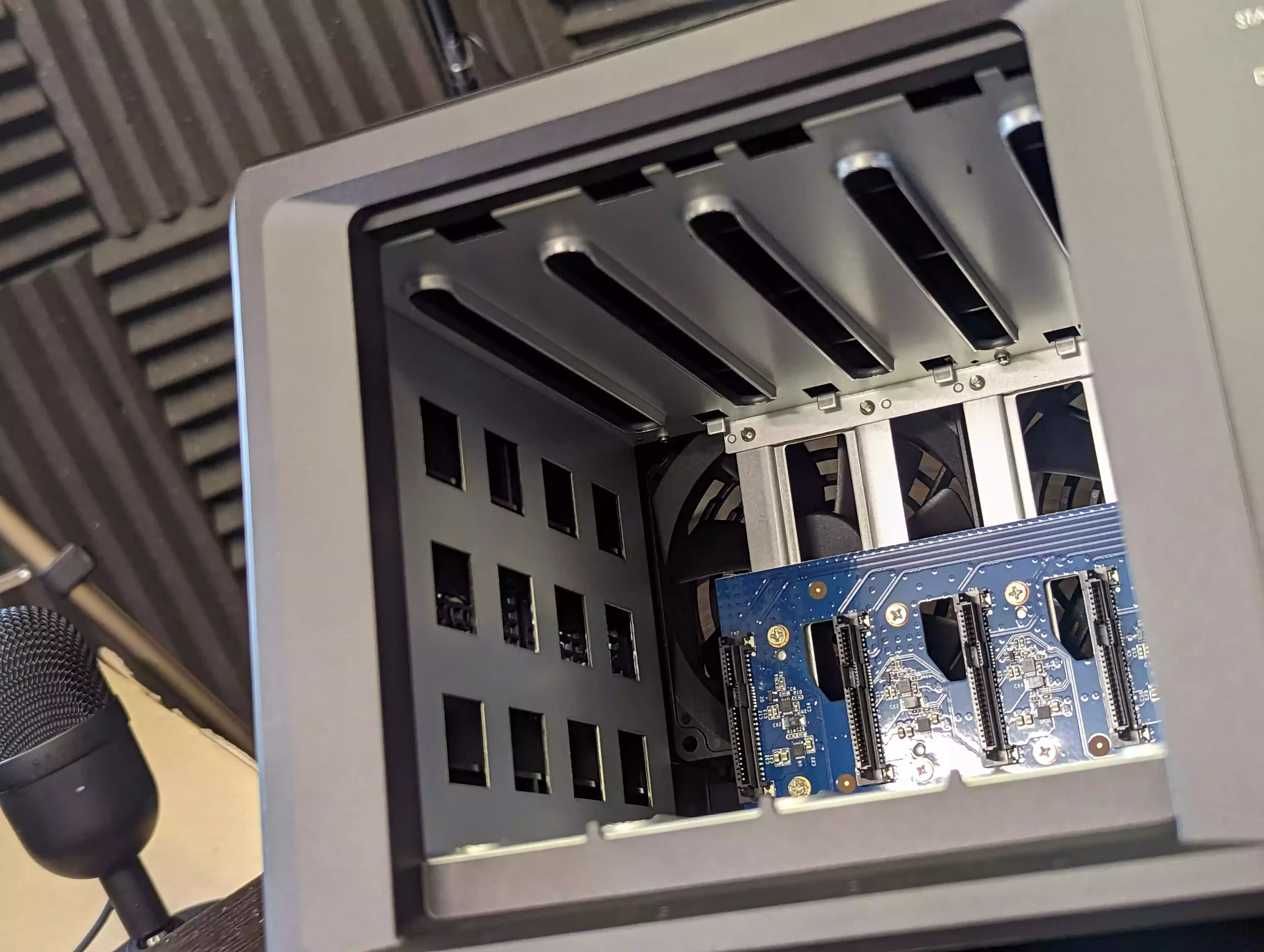
Taking all four trays out of the NAS reveals the internal board that connects each drive to a single PCB/Circuit board. This board is connected to another main processor board at the corner (the latter featuring the CPU and Memory). The SATA connection board inside is a nice, clean and clear connection. No power cables internally, no unnecessary bumpf – just exactly what you need to do the job well and made to be as frictionless as possible.
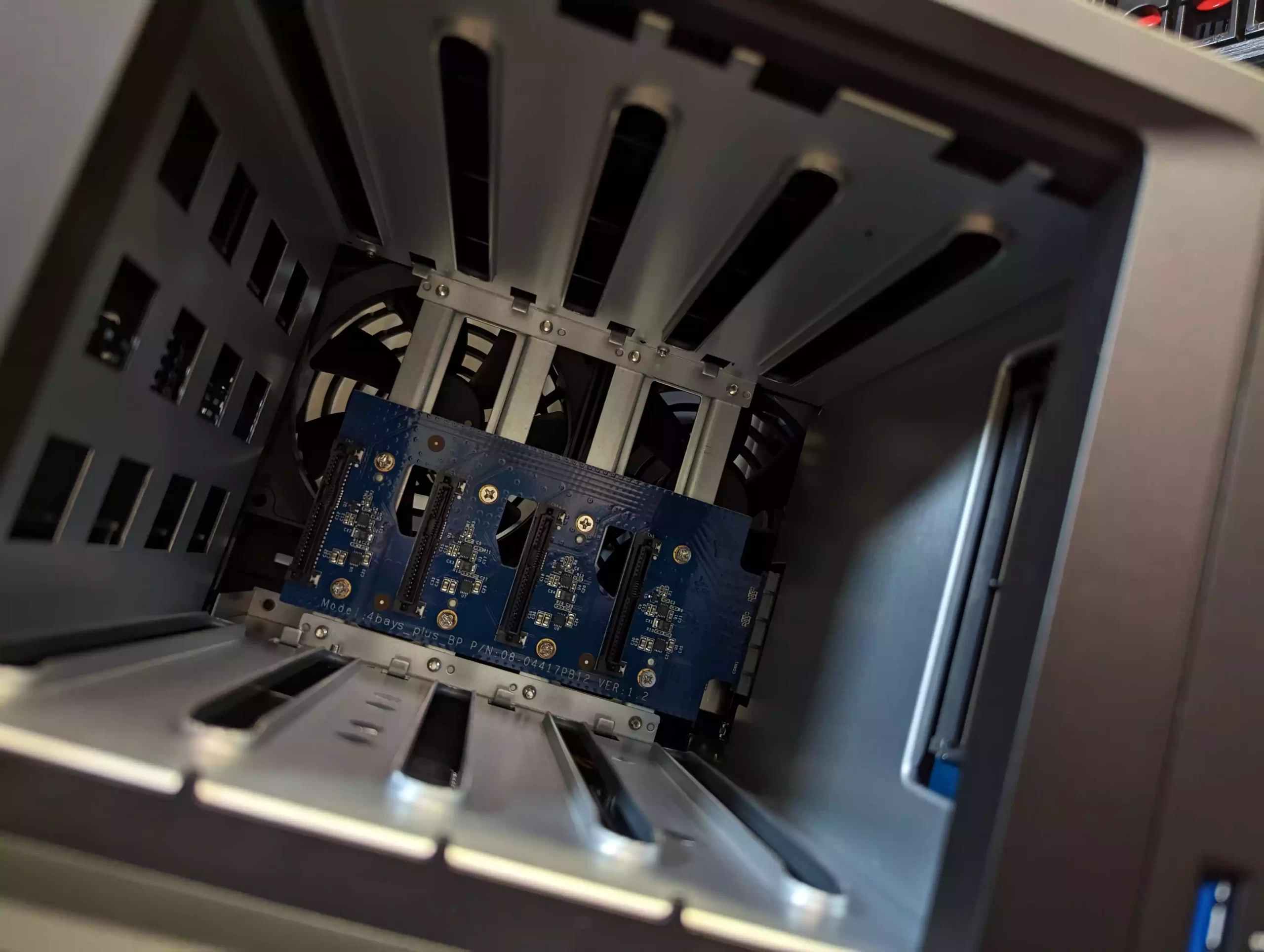
You can see above just how much of the area of the HDD bays are going to be covered in ventilation from the rear cooling fans whilst this device is cooperation. Heat is the enemy of most technology and storage media devices are no different on this score. Also in this area is the expandable memory bay. Now, again, this is an area of disagreement! The CPU inside the DS423+ has an officially support memory maximum of 8GB of DDR4, however the DS423+ arrives with 2GB of Memory by default, which arrives pre-soldered to the main board (i.e cannot be removed in any way).
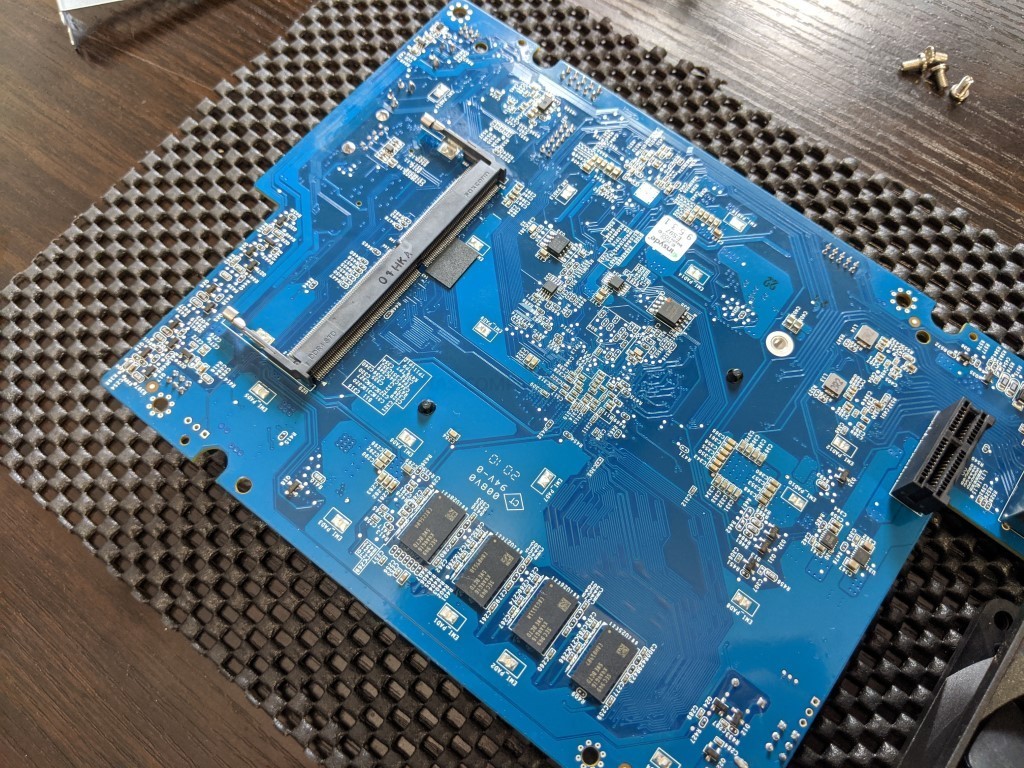
This means that you can only officially upgrade the DS423+ via the single SODIMM slot towards 6GB with a single extra 4GB SODIMM module in the available bay. Aside from 6GB being an odd amount, people are most certainly going to make comparisons with the DS920+ having 4GB on Day 1 and 8GB max.
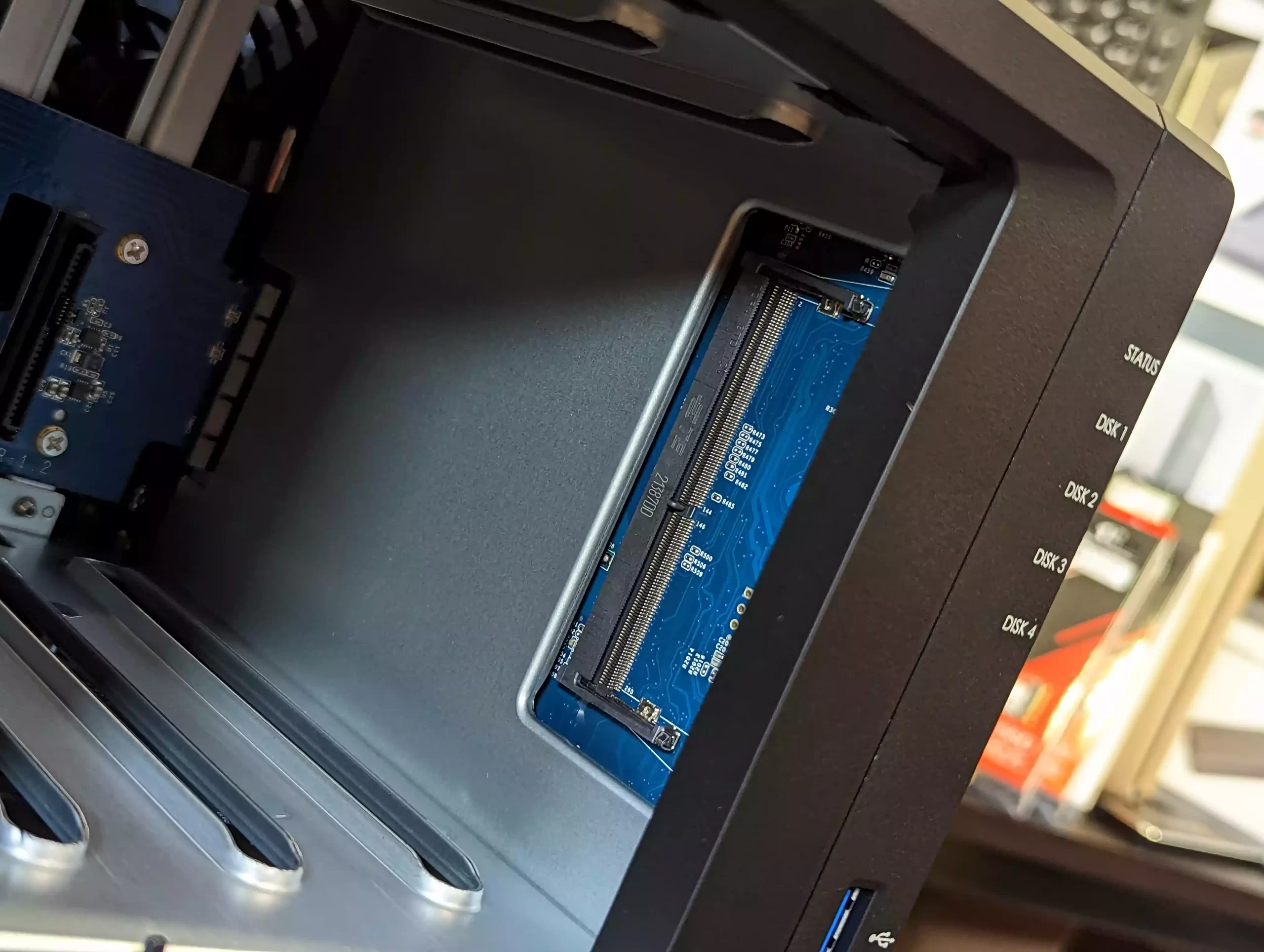
Now, Synology does not allow upgrading that memory beyond 6GB in this configuration (Intel Max limit on this CPU is 8GB), stating that using the system in an unsupported fashion can lead to weakened/invalidated support by the brand when you need it (as you are using the device in a configuration they did not verify and/or cannot replicate). This also includes using 3rd party memory, instead of their own branded modules I can partially see their point – they want to run a smooth, reliable and stable platform. Just a shame that Synology Memory modules are a noticeable degree more expensive than alternatives from Crucial and Kingston. Next we need to discuss the CPU inside the DS423+ NAS – something of a hot point for some.
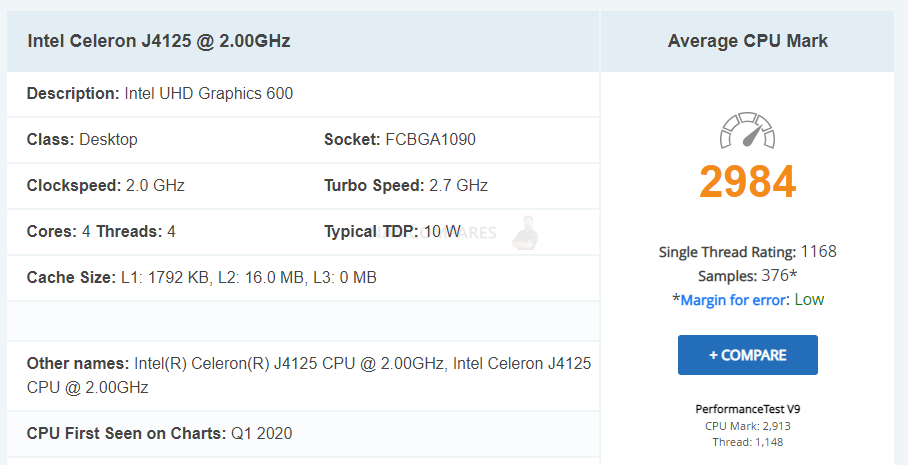
There are two very distinct ways to view the Intel Celeron J4125 CPU inside the DS423+. On the positive side, its a new Synology NAS with a very competent Intel CPU inside, quad-core architecture at 2.0-2.7Ghz clock speed, integrated graphics for demanding server-side processing like multimedia conversions, VMs, thumbnail management and increasing AI ops in Synology/3rd party applications. This is the first ‘Plus’ series release by Synology (i.e Prosumer/full-featured) to feature an Intel Celeron processor since summer 2020 – with everything else since either being efficient ARM processors or Embedded Ryzens without integrated graphics. This CPU does a great job of running synology DSM and will comfortably run a large range of applications, supported users, backups and surveillance cameras at any given time. Finally, there is the fact that till now, the DS4xx+ range has always been a dual-core processor and always lived noticeably in the shadow of the DS9xx+ system in the brand’s portfolio. So, the DS423+ arriving with that quad core Intel Celeron processor is definitely good news! Much like previous Synology NAS systems, the Intel Celeron CPU is located under a single, large, passive heatsink (no active cooling fan), which also means that ambient system noise from system cooling is reduced too. So, why would there be any reason to be unhappy about the DS423+ and it’s CPU choice?
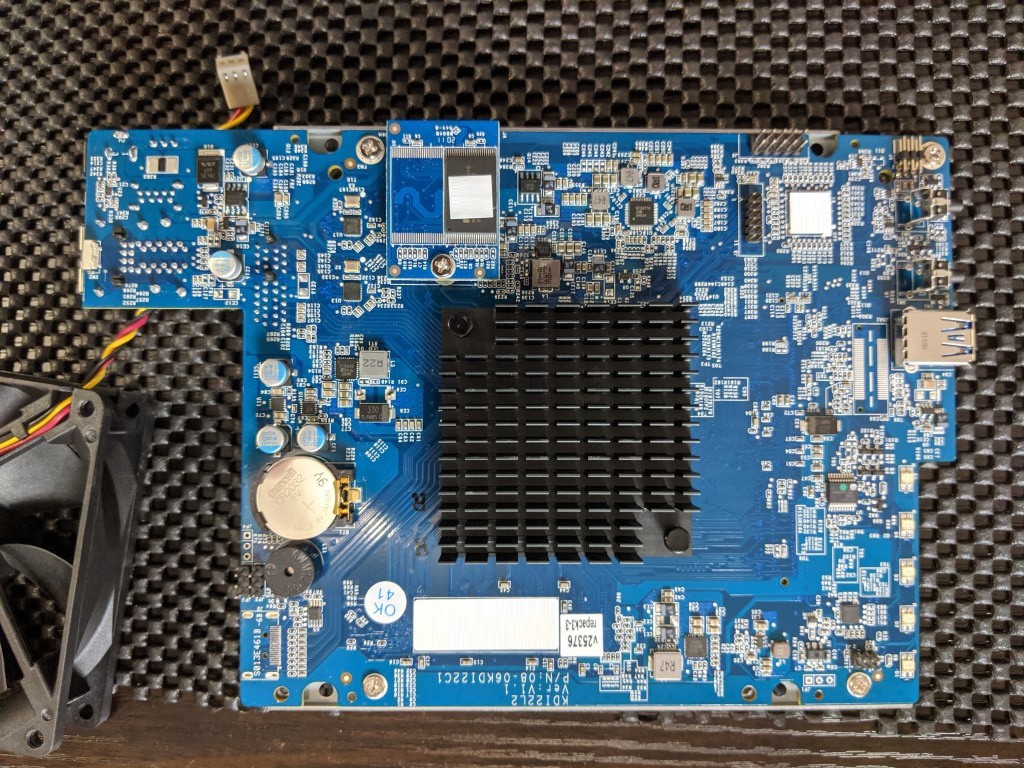
Synology DS423+ vs DS920+ NAS Comparisons
Well (and this is going to get VERY ‘inside baseball’), but those that have been following Synology these last few years will know that this is not the first time the J4125 has been used on a Synology Plus series NAS. Indeed, it has appeared several times in previous NAS systems (DS920+, DS720+, DS620slim, DVA1622 and DS1520+) love the last three years. In that time, not only has Intel moved on a couple of times to new cycles of processors (the N5105, N5095, J6415) which provide better power efficiency, PCI gen support and memory caps, but also competitor NAS brands have rolled out 1-2 more generations of hardware with configurations that capitalizes on Intel’s newer Celeron models. Now, it CAN be argued that because Synology have spent so much time and research exploring the capabilities of this processor, that they can get the most out of it for DSM. Equally, Synology has always been very clear that the jewel in their crown (and indeed the main selling point for their systems) is the DSM software and not the hardware. Then there is the fact that ‘at least it’s an Intel integrated graphics CPU, when Synology has been very ‘AMD Emb.Ryzen’ heavy of late! Finally, there is the argument that when the J4125 was featured previously, it was in their fully-featured ‘SMB’ tier – so the DS423+ in their more affordable Home/Prosumer tier is actually scaled up in having this quad-core Celeron processor. There are ALOT of different ways to look at Synology putting the Intel Celeron J4125 in the DS423+ NAS. But I think it would be fair to say that users of the DSx16+ and DS18+ generation that opted to skip the DSX20+ generation to ‘wait and see’, might be a little underwhelmed. Lets discuss the Synology DSM software and what the DS423+ can do for you and your data.
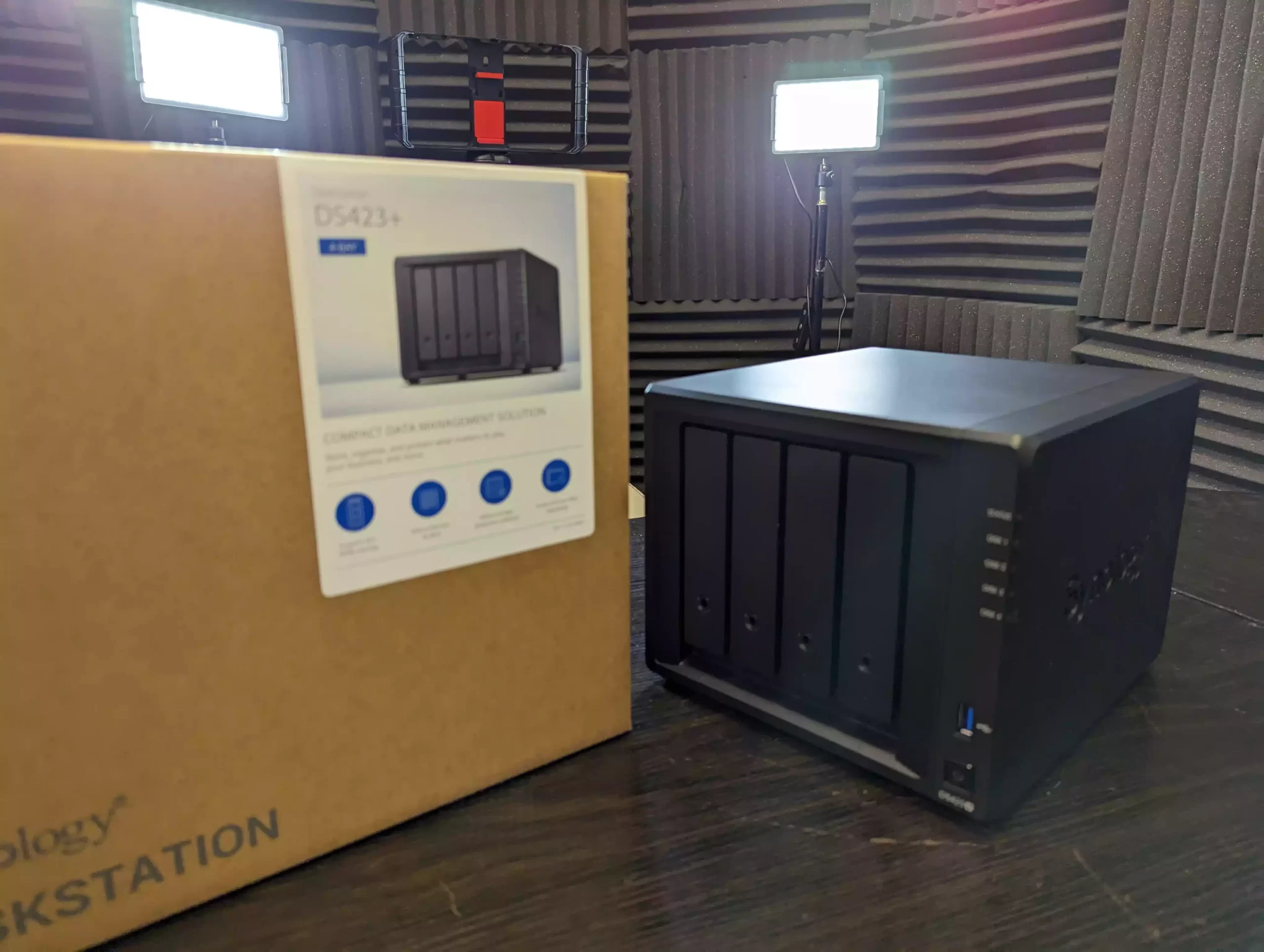
Synology DS423+ NAS Review – Software and Services
At Launch, the DS423+ NAS arrives with the latest version of Synology software, DSM 7.1. However, this does not stop evolving as soon as you get your Synology NAS. DSM has been in continues to be the dominant force in the world of NAS software, providing a massive arrangement of services, applications (first and third-party supported) and a huge number of client applications for desktop, mobile, Windows, macOS and Linux (as well as a bunch of other more home-based tools). These allow management and access to the data on the DS423+ in very tailored ways, as well as the web browser-based access that has the appearance, intuitive design and responsiveness of a local operating system. The DSM interface can be accessed by hundreds of users at the same time (with each user having tailored access, rights and privileges). DSM is available with ALL Synology NAS and the depth and abilities of DSM on any NAS are dependent on the hardware architecture of the NAS itself. In the case of the Synology DS423+, it supports EVERYTHING that is offered by Synology’s platform. DSM is currently in version 7.1, but it looks like we will be seeing beta/full release of DSM 7.2 at the start of 2023, which will be adding WORM (write Once Read Many) support, Volume scale encryption and numerous improvements to individual applications. If you want to learn about the DSM 7 and the software and services that are included with the DS423+ NAS, watch my FULL review below (alternatively, you can read the DSM 7 Full Review HERE):
As mentioned, the DS423+ supports pretty much the entirety of the DSM 7.1 applications and services (DSM 7 and DSM 6.2 are still in circulation and still receive regular service and security updates, though the DS423+ will arrive with DSM 7.1 by default and cannot be rolled back). If you are an existing user of SaaS and PaaS (Software as a service and Platform as a service) from the likes of Google Workspace and Office 365, knowing that you can synchronize these systems or choose to export away from them onto the Synology services is going to be very appealing. Then there is the increasing development of their 1st party cloud platform, Synology C2, which is slowly integrating into all the applications that are available on your bare metal NAS (allowing you to add a cloud layer of backup, synchronization and access to your data storage setup). This is a subscription platform, which can only be used with your Synology NAS system (as well as connected with some 3rd party SaaS services, but for those that are moving away from Google/Microsoft/AWS for security reasons, but still want a Cloud+Metal storage network in place, C2 covers pretty much everything. Indeed, although below I have highlighted a number of the key/best applications that are included in your DS423+ Service with DSM, most of them can be immediately integrated with Synology C2 (with even more being added in 2023 with DSM 7.2). Key business and consumer applications that are included with your NAS are:
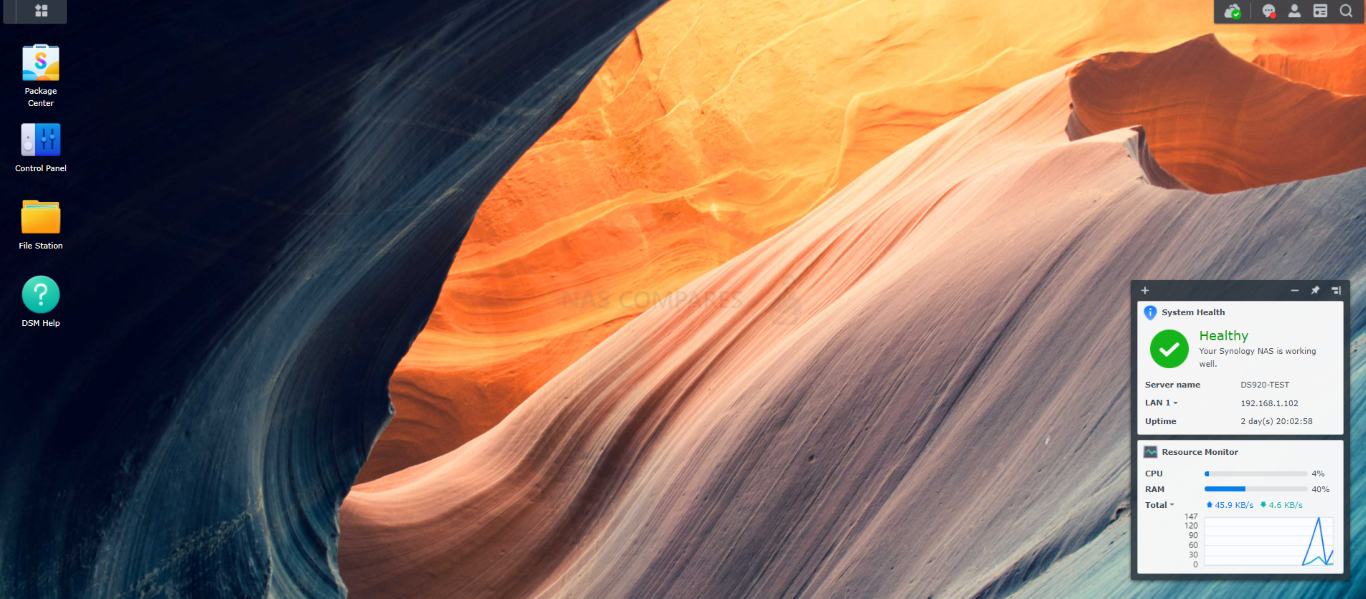
Synology Office – Create documents, spreadsheets, and slides in a multi-user environment. Real-time synchronization and saving make collaboration a breeze.
Synology Chat – Aimed at businesses, Synology Chat is an IM service that transforms the way users collaborate and communicate.
Synology Drive – Host your own private cloud behind the safety of your NAS with 100% data ownership and no subscription fees. Drive has become one of the premier applications of DSM and allows uses to create intelligent shared team folders that support versioning, file streaming+pinning, encryption, Windows AD support (soon) and native file system support with Windows and macOS.
Synology Photos – Manage your photos and videos with deep-learning algorithms that automatically group photos with similar faces, subjects, and places. Designed after the merger of Synology Photo Station and Moments, it also includes tailored folder, sharing and categorization features to help photographers manage their photos and share them with clients for feedback or business development.
Synology Calendar – Stay on track, share calendars, and schedule meetings, while ensuring sensitive information remains safely stored on company premises.
Synology Active Backup for Business (ABB) – Consolidate backup tasks for virtualized environments, physical servers, and personal computers, and rapidly restore files, entire machines, or VMs – license-free. This software also arrives as a specialised Microsoft Office 365 and Google Workspace platform to sync with those platforms and allow a bare metal tier to your cloud office services
Synology Hyper Backup – Backup your NAS safely and efficiently to multiple destinations with deduplication, integrity checks, compression, and versioning.
Synology Surveillance Station – Safeguard your business, home, and other valuable assets with reliable video surveillance tools. With improved AI services being accessible thanks to Synology BC500 and TC500 Cameras arriving in 2023. Additionally, you can connect this platform with Synology’s cloud platform to use ‘C2 Surveillance’ and bolster the odds of recordings being maintained in the event of accidental/malicious damage to your surveillance system.
Synology Virtual Machine Manager (VMM) – An intuitive hypervisor that supports Windows, Linux, and Virtual DSM virtual machines. Its powerful disaster recovery tools help users achieve maximum service uptime.
Synology High Availability – Synology High Availability (SHA) combines two Synology NAS servers into one active-passive high-availability cluster, alleviating service disruptions while mirroring data.
Synology Central Management System (CMS) – Synology CMS allows you to manage multiple Synology NAS servers quickly and conveniently from a single location.
Synology Video Station – Manage all your movies, TV shows, and home videos. Stream them to multiple devices or share them with friends and family.
Synology Audio Station – Manage your music collection, create personal playlists, stream them to your own devices, or share with family or friends.
Synology File Station – Manage your Synology NAS files remotely through web browsers or mobile devices. This tool allows complete file management and contains all the features and services of your own native file management platform (archiving, extracting, Copy, Cut, Paste, Sharing, native file format opening, integration with the rest of the Synology applications, property/metadata access, etc)
You cannot really fault the software and services that are included with the Synology DS423+ NAS, as you are going to get the very best experience available on the platform, thanks to the hardware and architecture of this NAS. DSM 7 is an ever-evolving platform, so if you are reading this now at the time of publishing or years later, there is always going to be something in DSM for everyone. That said, Synology in recent years has been increasing its priorities towards first-party software and services. This does make sense, as they want to promote their systems and software as a complete ecosystem for your home or business data storage needs (going on in the last few years to release even more Synology alternatives to popular software AND releasing non-NAS hardware accessories such as Routers, Network Adapters, HDDs, SSDs and now IP Cameras). This can occasionally lead to the compatibility lists of hardware or software that you wish to use in conjunction with the DS423+ NAS being a little smaller/restricted than you might like. A specific 3rd party software/service or physical accessory (HDD, Memory module, Network Upgrade) might not appear on the Synology compatibility pages, but that does not mean it will not function with the DS423+ NAS. It is more a case of Synology choosing not to test/evaluate a particular setup (in their defence, there are ALOT) and therefore until stated otherwise is therefore listed as incompatible and is therefore being used without their full, guaranteed support long term. In short, you can DEFINITELY feel that DSM 7/7.1 is a fantastic NAS platform, but it comes with a certain degree of rigidity by Synology on the DS423+ NAS. A little more relaxed than entries in the Enterprise XS or SA systems, but it is definitely still there.
Synology DS423+ NAS Review – Conclusion & Verdict
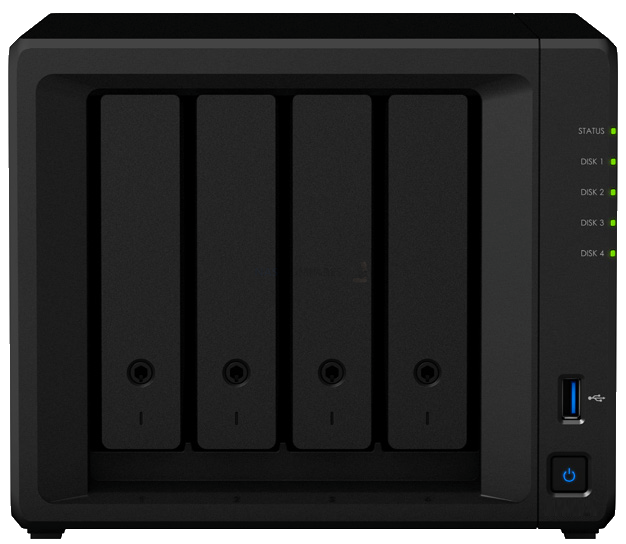
There are two ways we need to look at the Synology DS423+ NAS. In one way, the Synology DS423+ DOES support all of the features and services that users demand in a fully-featured home/prosumer solution. It features an Intel Quad Core processor with embedded graphics, DDR4 memory, multiple gigabit ports, wide HDD/SSD compatibility and m.2 NVMe SSD support. These are all things popular and most certainly what users would want/expect in a fully featured home/prosumer solution (aka SOHO). Then, when you roll in DSM 7 and it’s enormous range of software and services, the DS423+ is an excellent NAS solution that counters a broad range of criticisms that were levelled at the DS923+ at launch. However, there is, of course, the unavoidable way that most long-term Synology users and those looking to upgrade an existing 2016/2018 Diskstation are going to look at the DS423+ – a Synology DS920+ with less memory and no expandability! For those that skipped the DSx20+ generation, the DS423+ is going to feel decidedly underwhelming at best and hugely disappointing at worst! Synology has made no bones that they prioritize their software and services, with hardware being an important but nevertheless secondary concern. The main criticism is that CPU being the same processor used in the 3 years previous generation. Intel has moved production away from the J4125 themselves several times (with most other NAS brands using the N5105 or J6412 right now) and although Synology has been known to move CPU architecture down through the generations previously, this is a particularly egregious example. If they had just scaled something up on this device, such as the network ports from 1GbE to 2.5GbE, add the option of a 10GbE upgrade or more over upgrade the base level memory from 2GB or 4GB. The Synology DS423+ IS a good NAS system and serves as a great means to enjoy the wide-ranging features of DSM privately or professionally! It just feels like more of a stop-gap system in some places and one that existing DS920+ or DS420+ owners will skip.
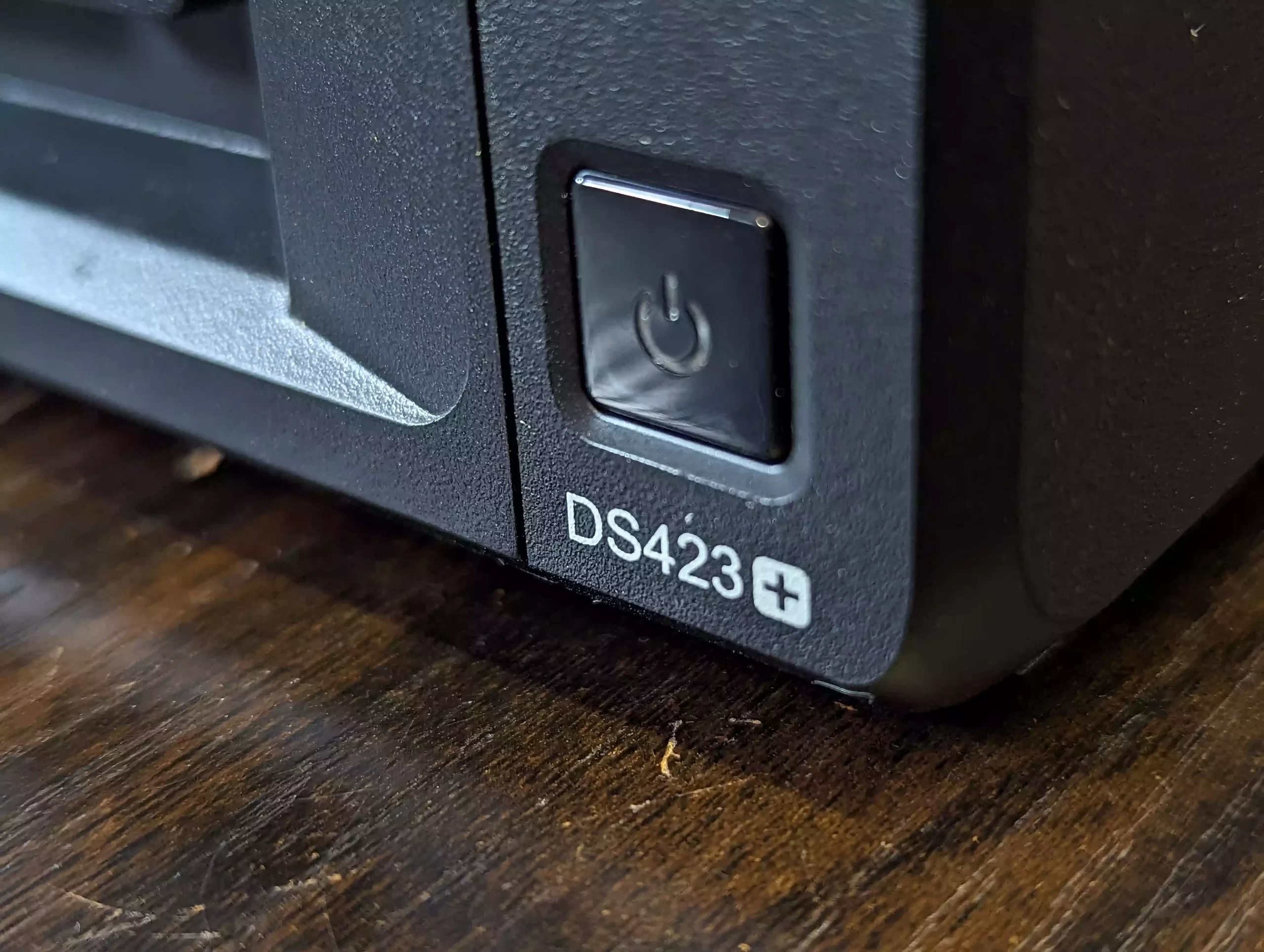 |
|
| Synology DS423+ PROS | Synology DS423+ CONS |
|
|
Need More Help Choosing the right NAS?
Choosing the right data storage solution for your needs can be very intimidating and it’s never too late to ask for help. With options ranging from NAS to DAS, Thunderbolt to SAS and connecting everything up so you can access all your lovely data at the touch of a button can be a lot simpler than you think. If you want some tips, guidance or help with everything from compatibility to suitability of a solution for you, why not drop me a message below and I will get back to you as soon as possible with what you should go for, its suitability and the best place to get it. This service is designed without profit in mind and in order to help you with your data storage needs, so I will try to answer your questions as soon as possible.
📧 SUBSCRIBE TO OUR NEWSLETTER 🔔 This description contains links to Amazon. These links will take you to some of the products mentioned in today's content. As an Amazon Associate, I earn from qualifying purchases. Visit the NASCompares Deal Finder to find the best place to buy this device in your region, based on Service, Support and Reputation - Just Search for your NAS Drive in the Box Below
🔒 Join Inner Circle
Get an alert every time something gets added to this specific article!
Need Advice on Data Storage from an Expert?
Finally, for free advice about your setup, just leave a message in the comments below here at NASCompares.com and we will get back to you.
 Need Help?
Where possible (and where appropriate) please provide as much information about your requirements, as then I can arrange the best answer and solution to your needs. Do not worry about your e-mail address being required, it will NOT be used in a mailing list and will NOT be used in any way other than to respond to your enquiry.
Need Help?
Where possible (and where appropriate) please provide as much information about your requirements, as then I can arrange the best answer and solution to your needs. Do not worry about your e-mail address being required, it will NOT be used in a mailing list and will NOT be used in any way other than to respond to your enquiry.
TRY CHAT
Terms and Conditions









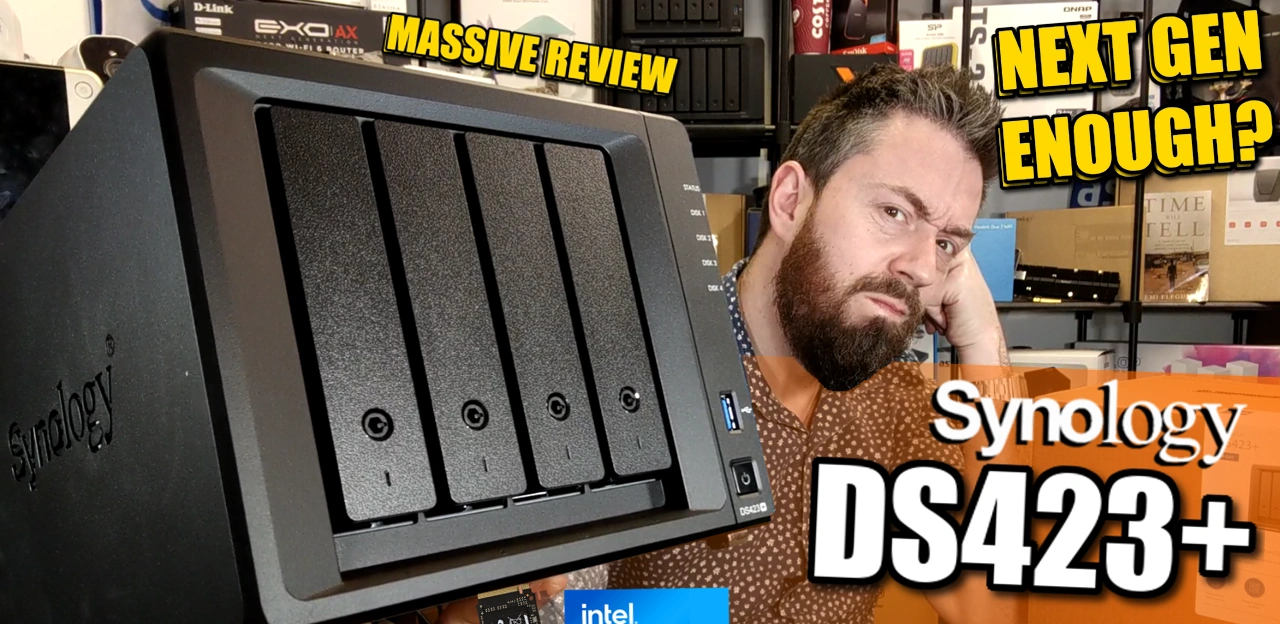




Extra like for the seagull’s flight. :)))
REPLY ON YOUTUBE
00:11 “Bee-tah!”
REPLY ON YOUTUBE
What is the Synology nas to buy for me to run Plex
Cheers
Jim
REPLY ON YOUTUBE
I plan to buy the 423+ to upgrade from my first DS220j NAS. Will the 423+ work with my current DSM 6.2.3?
REPLY ON YOUTUBE
As someone new to NAS, it would be helpful when you say things like ‘low noise’ to demonstrate it.
REPLY ON YOUTUBE
Are we going to get an M.2 NVMe compatibility test for the DS423+ given you’ve already done memory? My old DS1813+ is on it’s last legs (time to retire after a decade) and needs replacement, predominately for Plex and Surveillance.
REPLY ON YOUTUBE
Hello everyone, I bought a Synology 423+, installed the drive inside, but on first power up I smelled a strong plastic and burnt smell.
The smell passed after few minutes and everything seems to work fine and in temperatures. I would like to know if this is normal.
The smell did not return again.
REPLY ON YOUTUBE
I hope you can help me!
I have sooo many files on my pc and external SSDs lying around on my desk. About 6 TB with videos, pictures and documents. Now that I’ve started a YouTube channel, there is going to be alot of video files!
All I want is a box with 4 bays (maybe go with two 12TB to start with), to store aaall of my files. I want to connect with a USB to my pc and have a decent speed when tranferring files from my computer and I want it all to be mirrored. The networking part is not so important to me. Is this Synology DS923+ for me? And what do I look for in a suitable harddrive? Thank so much and cheers from Norway!
REPLY ON YOUTUBE
I bought DS423+ after comparison reviews from your channel, and watched this video while still waiting for it to arrive. Great job! Is someone at the door? it’s my NAS arrived!
REPLY ON YOUTUBE
Synology gone downhill
REPLY ON YOUTUBE
Had this on in the background over a couple of days. This is the comment you requested — I made it to the end! =D
It’s definitely not in the budget for me yet, but I’m dreaming about a NAS in my setup in the future!
REPLY ON YOUTUBE
Can you use other brands’ nvme drives for storage pool or does it have to be the Synology brand?
REPLY ON YOUTUBE
Is there a suitable ( AC power cord extension for synology ds423+ ) would a 4 Pin DIN Connector Cable, 4 Pin DIN Male to Female Extension Connector Power Supply Cable for Audio Digital Devices (1 meter) possibly work ?
REPLY ON YOUTUBE
Dumb question nas noob here, If I Plug my nas in, in a different room so to a different ethernet socket, Will i be able to connect to it as normal? Or will its ip change and Ill have to set it all up again?
REPLY ON YOUTUBE
The more I watch your videos the more confuse I get. I went from buying the 220 to the 923+ to the 423+ to being discorage to buy anything… DS923+?
REPLY ON YOUTUBE
The more I watch your videos the more confuse I get. I went from buying the 220 to the 923+ to the 423+ to being discorage to buy anything… DS923+?
REPLY ON YOUTUBE
I think I am going with the DS423+ model cause my main reason is to use as a Plex Server and my current router is limited
to 1G speeds.
REPLY ON YOUTUBE
I love that this guy’s short review is still 20+ minutes. I appreciate the dedication and passion. Thanks for the the tips. I think I am finally getting a NAS this year cause all of your content.
REPLY ON YOUTUBE
Could I use Synology DDR4 4GB 3200 ECC on the DS423+?
REPLY ON YOUTUBE
Is it compatible with the Seagte Exos X18 18TB drive?
REPLY ON YOUTUBE
i never had a nas. this will be my first nas. if i understand right i prefer this over the 923+ cause of the intel cpu. in only need the nas for 4k media stream on my tv. am i right? or maxbe should i wait for sth else i dont know. thanks for your help guys
REPLY ON YOUTUBE
Why would anyone, at this moment, buy DS423+, when DS920+ is still available, cheaper, with more RAM, and has ESATA port for further 5 HDD extension…
DS920+ will probably get NVMe, in couple of months (when there no more to buy new), as Synology now has no “hardware explanation” (which is their main explanation that PCI-E 2.0 is problem)
why it cannot be enabled (as same hardware 423+ has it)
REPLY ON YOUTUBE
I was able to pick up probably one of the last “new” ds920+ for $849 USD in April 2023. I probably would have went with the 423+ for over $200USD less if I had seen this first. I upgraded from a d218+ (I think) and wanted the GPU and extra drive bays for Plex.
REPLY ON YOUTUBE
I love your videos, but you’ve spent 8 minutes talking about something you can clearly read in 25 seconds on the beta landing page. Not for production environment, selected units supported… oh man… 😉
REPLY ON YOUTUBE
cha ching:No Sale.
REPLY ON YOUTUBE
Cheers guys @NASCompares for your informative/experienced inputs vlogs. (I hate seagulls, too ;-)). You talk a bit fast in your presenting ‘style’ to my ear, however, if I missed what you’ve shared, I can rewind. :-). You certainly have ‘good’ energy/passion/experience! Thank you for that! You’ve helped me decide on what NAS to buy. (DS-423+) (suitably boring but exceeds my needs enough) and I will use your link to possibly buy via Amazon if price is OK next week. If I can’t share my gratitude in a small way via that route, I will send a donation. Many thanks. You also gave me a valuable ‘feel’ for which type of drive etc., to purchase and how to slowly build a NAS system without ‘overspending’/making mega mistakes., etc., ????
REPLY ON YOUTUBE
is the ds418 model more than the ds 423+ for the beginner photographer ???
REPLY ON YOUTUBE
Just collected mine today ..Your previous videos I watched made me decided this is the one. This is my first NAS purchase.
REPLY ON YOUTUBE
Breathe . Speak slowly
REPLY ON YOUTUBE
I love(d) my DS916+ and considered getting a newer and bigger Synology. But since being forced to buy re-labeled and ridiculous priced OEM hdd/ssd drives I am out. TrueNAS Scale and a more potent while cheaper self-build server are my way to go now. Thank you Synology for the good times so far … but I won‘t come back. Hopefully many others think the same.
REPLY ON YOUTUBE
i did watch the whole video
REPLY ON YOUTUBE
Why in hell I can’t buy ANY Synology NAS!!!!!!! ????????? all have issues to avoid to buy them, why they don’t want release a real solution for everyone.
REPLY ON YOUTUBE
Can you confirm on the usage of a 16gb memory ? Seems like even if not officially supported, it does does run it ok.
REPLY ON YOUTUBE
Webp photo support will hopefully come to iOS too
REPLY ON YOUTUBE
If a drive isn’t on the compatibility list will it work with a warning or you can’t use them at all?
I use some basic desktop Seagate in my old rn31400. Will I still be able to use them in a Synology Nas (obviously re formatted).
So I can’t buy just any nvme drives to use. I would like to put 2 nvme drives , 1 for storage and 1 for cache. I was thinking some affordable ones like whatever goes for $80 for 1tb drives.
REPLY ON YOUTUBE
Good Vid as usual. Still disappointed in Synology and their going proprietary. Currently have a 416play with HDD but really want another for redundancy. Simple of fact of not being able put in affordable SSD’s is a huge issue for me. Samsung 870 Evo 2TB drives are perfect and priced right. I wish they would just open them back up again….
REPLY ON YOUTUBE
Ready to buy a NAS but I am torn between synology and asustor. From watching your videos, I guess in a nutshell it is a choice between superior software vs superior hardware for the money, respectively. As an Apple hw user (I use others including windows and Linux since I’m in enterprise “IT”) I’m a bit fed up with price gouging with proprietary hw when spending my own money. Is the software worth the expensive and proprietary hw both initial and future upgrades on the synology side?
REPLY ON YOUTUBE
There is a Chinese nas called dx4600, which is quite nice! Hope you can have a video about it
REPLY ON YOUTUBE
2 gb ram. 1 gbe. 4 year old proc. Efff off Synology. Pay hardware dept more. Pandemic is over. Ppl have money. We want to upgrade to good stuff. Not this.
REPLY ON YOUTUBE
Nice to see Synology recycling the leftovers from the DS920+ manufacturing plant. ????
DS-bubble & squeak
REPLY ON YOUTUBE
NOPE… I’m trying to upgrade from an ancient second-hand Synology that admirably still works but is not compatible with the latest DSM software. I’m not going to pay top dollar for a repurposed model from 2020 with a cpu from 2019! I was waiting for the ds423+ to come out but I’ll wait for a sale on the ds923+ instead. I don’t know what Synology is thinking, but the ds423+ is dead to me.
REPLY ON YOUTUBE
DS423+ is a downgraded DS920+. But you can’t get a DS920+ cause they discontinued it. Damn Synology. Pisses me right the hell off.
REPLY ON YOUTUBE
This old Celeron doesn’t support AVX ……. this limits the use of more DOCKER
REPLY ON YOUTUBE
I’m still using a DS414 at home mainly just for file/multimedia storage and CCTV surveillance station. Looking at this 423+, I can’t see a good reason to upgrade and I certainly don’t know why people with the last 1 or 2 generation models would even think of upgrading. For me, like many others have said, a lack of 2.5Gb LAN is a deal breaker. I want my NAS to last well over 5 years (coming up to 9 years on my 414 now) so it needs to be up to date / future proof and 1Gb LAN is not. Especially when you think a bare unit is like £500.
REPLY ON YOUTUBE
My DS415+ just died on me yesterday….
So I guess I’ll buy the DS423+ because it is the newest option on this range ?
Yes, correct.
The 423+ is compared to the 920+ in this review, but even having only the 918+ myself I see no reason to upgrade. I wonder what Synology will have in store for us when the x25+ series are released in two years time. If it comes with a better Intel Celeron CPU and 2,5Gb ethernet on board I might consider the upgrade at that time. But I am leaning towards a 5-bay NAS in the future (now using SHR-2 with 4-bays which is a bit of a waste), so let’s see what the next Synology models will bring.
REPLY ON YOUTUBE
Great review as always
REPLY ON YOUTUBE
“Innovation distinguishes between a leader and a follower.” —Steve Jobs
REPLY ON YOUTUBE
Is the price 499?
REPLY ON YOUTUBE
These NAS are so expensive now that sometimes I think is cheaper build a PC for this purpose. On top of that, the expansion is also way easier and possible.
REPLY ON YOUTUBE
This is a downgraded DS920+. The lower RAM alone is a deal-breaker when you factor in cost.
REPLY ON YOUTUBE
This seagull got a real kick in cojones ????Thanks for the preview. I’m looking forward to see how DS423+ stacks up against competition.
REPLY ON YOUTUBE
B&H Photo lists this for pre-order at $499 US, so $100 less than the DS923+.
REPLY ON YOUTUBE
Synology hopeless tentative response to the angry Plex clients over the last releases, just obsolete hardware, stay away from this, chose any other brand with 2.5GB network and a NEW intel CPU with integrated graphics.
REPLY ON YOUTUBE
thanks for the link, but no price, no offers there yet 🙂
REPLY ON YOUTUBE
………..what do you think of the “QNAP Turbo Station TS-364-8G, 8GB RAM, 1x 2.5GBase-T” ?????
REPLY ON YOUTUBE
Sad, they should have updated the CPU or continued the popular DS920+ production & availability.
REPLY ON YOUTUBE
I can do direct stream plex 4k hevc with only audio transcoding which is about 25℅ CPU utilization on a 1522+.
REPLY ON YOUTUBE
Other than the 2nvm couldd be a storage pool I don’t see any other reason to buy this over the 920+
REPLY ON YOUTUBE
Essentially I use my 720+ for Plex and very little else. One drive as redundancy is fine and I use 2 x 8TB Red. Considering going 4 bay more for the extra redundancy of RAID 5 despite the extra drive cost. I send movie files through my Apple TV 4K so I understand that I dont actually need integrated graphics to handle 4k and different formats. But still, It feels strange not having integrated graphics…just in case
REPLY ON YOUTUBE
Am I the only one who needs to watch his videos at 0.75x speed in order to understand/keep up?
REPLY ON YOUTUBE
@NASCompares Wondering when QNAP might get some love? I have been seeing emails over the last month or two so that I would have thought would have caught your interest? The Security Bounty alone I thought I was going to see one of your quick deliver videos… Even the updates for the OS in the last 8 months or so have been interesting.
REPLY ON YOUTUBE
Thks & buts !DS823+ or Bust!
REPLY ON YOUTUBE
Who cares about fast stoage pools on 1GBE
REPLY ON YOUTUBE
Another Synology hardware fail.
REPLY ON YOUTUBE
https://youtu.be/Sv6A0vMBtJ0?t=1295 Got mine at the right time!
REPLY ON YOUTUBE
The CPU is fine because it’s a 423 series… The bigger CPU will roll out hopefully for the upcoming generations. This is the clearly the base model with base model hardware.
REPLY ON YOUTUBE
go TrueNAS….
REPLY ON YOUTUBE
I tried to resist watching this, but as always I couldn’t hold out. I am afraid that you’ll sell me on buying this NAS too. I’ve already got two on my list. Still deciding on which ones to buy.
REPLY ON YOUTUBE
Yep, 920+ bought about 7 months ago. Replacing Unraid on Dell PowerEdge R510
REPLY ON YOUTUBE
IF this actually had all the hardware of the QNAP TS464 in the synology box how much more would you pay over the DS423+ retail price?
REPLY ON YOUTUBE
I want to have a NAS as a Media server, saving movies and Pictures. I’m still not sure what I need…lol. Money is not realy an issue, but don’t want to get something I don’t need. It will be in my Living Room, so it need to be quiet, hence I’m planning to use SSD’s only. I’m not sure if 4 Bay or 2 Bay due to back up (I know a NAS is not a back up system). So far I’m looking at the 4 Bay Qnap, (they look like something I put in my living Room).
REPLY ON YOUTUBE
Very level headed points, thanks. Absolutely shocking that the 920+ doesn’t support M.2 storage, though I’m not sure the 423 would have many selling points if it did!
REPLY ON YOUTUBE
Looks like it’s 920+ but without extension slot
REPLY ON YOUTUBE
The fact that its 1 gig is enough for me to pass, that’s just sad Synology. Practically E-Waste. Its so cheap to have 2.5 or even 1 10g. Really was looking forward to getting a smaller Synology NAS soon for redudant backups and camera server use at a different site but can’t justify the cost with the lack of the expansion
REPLY ON YOUTUBE
no get qnap
REPLY ON YOUTUBE
They have finally added the support of storage spool creation with M.2 ssd for the ds1522 and some more. ????
REPLY ON YOUTUBE
Worm is kind of a strange name. When you talk about worm in IT you would think of a piece of malware instead of security feature. Still a nice addition though.
REPLY ON YOUTUBE
Beeta and colour. Why you Brits must torture us poor Americans?
REPLY ON YOUTUBE
they can stick it
REPLY ON YOUTUBE
Any changes with nvme storage pools using third party nvme drives? Thnx.
REPLY ON YOUTUBE
Make video on best ps5 ssd for 2023 summer according to prices and transfer speed
REPLY ON YOUTUBE
lmao, they finally brought some features back they removed from DSM 7.0, what an amazing “update” 😀
REPLY ON YOUTUBE
Any info on NVMe storage pools? Particularly on older models like the 920 but interested about any other changes regardless.
REPLY ON YOUTUBE
Are we getting the ability to mount NVME M.2 drives as storage area and not just cache? I’m running DS720+
REPLY ON YOUTUBE
Thanks for the details, but I’ll wait until 7.2 is well out of Beta and perhaps the 1st patch to it is out.
REPLY ON YOUTUBE
Either 7.2 is taken down or it’s region specific. Here in US it redirects to the 7.0 page
REPLY ON YOUTUBE
I’d suggest the following topics for later videos:
1. Upgrading from encrypted shared folders in DSM 7.1 to encrypted volumes in 7.2
2. Multichannel SMB performance comparison—test e.g. connecting from a 2.5GbE PC to 2-3x 1gig ports on the NAS
REPLY ON YOUTUBE
As exos offers disk encryption, why do I want dsm to do that?
REPLY ON YOUTUBE
I think, I’ll wait too. I’m interested in the encryption stuff.
REPLY ON YOUTUBE
7.2 download page has been removed.
REPLY ON YOUTUBE
Well, for me your link goes to the download for 7.0.1….maybe you’ve jumped the gun a bit…
REPLY ON YOUTUBE
Do we know, in which OS version, when immutable backups, via Hyper Backup and/or C2, will be released?
REPLY ON YOUTUBE
Aren’t filename or filepath lengths supposed to be seriously limited when this encryption mode is on? Can you perhaps do a test? Thanks!
REPLY ON YOUTUBE
It is always a disappointment without better synology photo app
REPLY ON YOUTUBE
I will wait until 7.2 is well out of beta before considering it. The only feature that interests me in 7.2 is SMB multi channel, so look forward to seeing how well this is implemented.
REPLY ON YOUTUBE
If you have a Synology box and can do setup VM , I installed the VM 7.2 beta works good , this can give anyone a look at this beta
REPLY ON YOUTUBE
Which kernel version is dsm 7.2 running?
REPLY ON YOUTUBE
Could you do an overview about the new Container Manager in DSM 7.2; , thanks
REPLY ON YOUTUBE
Any tips on how to encrypt a volume without deleting / recreating the volume ? (stupid question probably…)
REPLY ON YOUTUBE
Dude, your taskbar is insane!
REPLY ON YOUTUBE
Great video again
REPLY ON YOUTUBE
Thanks for the explanation! Do you know if we can convert an existing volume to be encrypted? Or do we have to create a new one?
REPLY ON YOUTUBE
I love hearing you waffle on Robbie. Thanks for making all this lovely content.
REPLY ON YOUTUBE
*IMPORTANT* I missed this in the video, but Synology have also enabled Containers in DSM 7.2 for certain Realtek NAS devices (DS223, DS123 and DS420j) with the new ‘Container Manager’ Application!!!!!
REPLY ON YOUTUBE
Fantastic video as always! Thank you! ????
REPLY ON YOUTUBE
Great content! Thanks for your time and experience!
REPLY ON YOUTUBE
I’ve seen reports of using the read-write cache option causing the entire raid volume to crash if an ssd fails, so I’m personally going to be sticking with the read cache only.
REPLY ON YOUTUBE
How this doesn’t have more likes is unjust. He covers so much and shows great examples. He also has time marks for reference. Great resource! Keep up the good work, would give you more likes if I could.
REPLY ON YOUTUBE
One thing I wish sonology would do especially further backup program is allow you to back up to a networked windows pool drive aka the NAS sync with networked multipooled Windows drive giving you to a form of backup even if you cannot see the data on the Windows pool that be fine if it was just an encrypted image or better yet allow the damn system to read Windows pool drives…. You’re plugging a USB hub with all your USB drives the nas makes its own virtual pool out of those drives and then it backs up just in case there’s nobody has a single 60 terabyte drive …. The fact that most people are coming from multiple hard drives externally to Nas and can’t use those multiple drives as a single pool backup is annoying especially when there’s hard drive crashes or or anything like that at least you’d have a personal backup I didn’t even pay 10-15 dollars per drive one time fee to make a pool for image backup
I literally had to Jerry rig using always-sync to back up the entire NAS drive on a 9 hard drive pool on the Windows side
REPLY ON YOUTUBE
Insert the biggest thing I hate about Synology outside of their “hard drive requirements” (if the damn hard drive says Nas supported then it should just work you shouldn’t need a specific hard drive) is them telling you where to put your media or files for specific programs they own you should be able to tell the programs just like in Plex where the files are where you wanting to put the files and have one way think as an option with no deletion
REPLY ON YOUTUBE
I personally find it difficult still for a novice user especially for making user accounts … Aka having public and private folders for individuals in a group setting (you can’t have both) we’re in the group setting everyone has the rules AKA right and no delete for public folder and the ability for only individual users in that group to only see their private folder and not everyone else’s
Aka private “Jon” public “all” private “Sarah”
John can still see Sarah’s folder
Because I haven’t nested in an outside folder public and an outside folder private where all their names are in the private folder so it’s nice and organized
But everyone can still see everyone’s folder I’d love to have it so that you can easily isolate nested folders
REPLY ON YOUTUBE
One application they should make is a network photo slideshow screen saver picture frame app with dslp and outside network
REPLY ON YOUTUBE
The one and only thing I don’t like about Synology multimedia apps or drive apps…. Is they TELL you where to put your media AND GENERALLY HAVE TWO-WAY SINK AS DEFAULT
Most users are going to have a plexa library that they’ve probably customized and should customize in one bulk “media folder” and then break it down within…. If you do stuff like that for all your multimedia they’re native apps don’t work you have to have it where they want it…. Same with sync you have to have it where they want it and it’s only sync … Me personally I want one-way sink data goes on the NAS … You can delete it off the phone or computer and that won’t transfer over…. They have improved the drive application but I still have to improve video photo and the other ones to be one way and for us to control the locations multiple or single nested location I don’t want to be told or you got to have it in the ” home /user /names/ photo/ to have the photo application work
NO I want to have it in plex media / photos/ cell phone 01/
REPLY ON YOUTUBE
why do I need raid 1 on the ssd cache? It doesn’t matter if the data is gone on the cache if one ssd fails. The data is stored on the HDD after a Data is altered in the read/write cache. or is written again from the HDD when a new SSD is added. So that makes no sense. Raid 0 would be better in this case.
REPLY ON YOUTUBE
Thank you for this Video!
REPLY ON YOUTUBE
Funny how that Security Advisor isn’t barking at you for having the standard 5000 and 5001 ports in use. Mine’s been yelling at me 24/7 about it.
REPLY ON YOUTUBE
That really is an in-depth and thorough review. I’ve had the DS1621+ for about a year and you’ve helped explain what some of the apps actually do. Thank you.
As a photographer using Lightroom to manage my my photos, I still cannot understand why I need Synology Photos or S Video to manage them?
REPLY ON YOUTUBE
Thank you for the detailed review. I am interestedin buying a new Synology Nas (920+) and i own an old XP 32 bit PC do you think there will be any issues about compatibility from Win XP 32 bit to the DSM 7.1 Synology NAs, in that case does any workaround exist?
REPLY ON YOUTUBE
I’m the one who watched the whole thing! And some bits twice. Very helpful in trying to decide between a Synology DS923+ and Qnap TS464. Synology seems to have the upper hand software-wise which I suspect carries more weight for a home user than the superior hardware of the Qnap? Thank you for providing this extensive review!
REPLY ON YOUTUBE
Awsome information. Now please a similar video on Qnap. I cant make up my mind as I need both photo management and video surveillance. It seems like Qnap and Synology takes 1 point each.
REPLY ON YOUTUBE
Jellyfin?!!! Most channels that review media server software, either only deep-dive their preferred offering, or only give an overview compression of the field. If someone like you, who can give the same enthusiasm creating two videos deep-diving two NASs that only differ by a drive bay, puts that into a spin-off series on a topic that is close to a large chunk of your demographic, that would be a real treat.
REPLY ON YOUTUBE
Thks & I just watched it again & most excellent;
I’m a retired physicist & have no real problem understanding the infinite details.
However my problem is how to keep it simple & stupid (ex: high tier levels of simplicity, brevity, encapsulation, etc).
Oh with my goal is to sociably knit-together all my family, relatives, friends, etc on my synology NAS.
Unfortunately I’m going to be Mr Tech support for them. Sooooo I gots-tos keep-it-simple is an understatement & I will be abused (I says anything for family/friends though ;).
REPLY ON YOUTUBE
I’m also only seeing 360. Can’t make out any screen. text
REPLY ON YOUTUBE
You’re a DSM PhD;
I never hear so dense of a presentation of great DSM info & my head is still spinning, thks.
Next-time, you think about having something good to drink every-once in a-while.
REPLY ON YOUTUBE
47:05 Where, When
REPLY ON YOUTUBE
Still only 360p for me
REPLY ON YOUTUBE
Still just in 360p
Hope it will fix soon.
Thx for all the effort!
REPLY ON YOUTUBE
Watched you video from begin to end! Loved the deep dive into DSM, since I am looking into buying a new Synology. Keep up your amazing videos!
REPLY ON YOUTUBE
Nice video. Does anyone know why my USB printer doesn’t work anymore on my Nas Synology ?
REPLY ON YOUTUBE
Thanks for a great video. Really explains what everything is. Recently got my NAS and been already updating hard drives in it. It will mainly be used as a PLEX Server but already considering what i will do when i start upgrading the smaller drives in it. May consider another NAS and use it as strict data back up and maybe a synology Drive / synology Calendar and Email setup. Move my calendar off Google’s stuff. We will see If i do that at some point. Great job again
REPLY ON YOUTUBE
Thank you for all the work you put into this. Very helpful.
REPLY ON YOUTUBE
My English man!!! What a video! Greetings from Greece! I really appreciate your hard work and that content. I have a DS 1520 + and I am not regretting getting it although the new 1522 is out. You have my admiration. Keep up the professional and good work.
REPLY ON YOUTUBE
Why only 360p is showing ????
REPLY ON YOUTUBE
Would it be too much to expect something similar for QTS?
REPLY ON YOUTUBE
Why 360p? Can’t see it clearly.
REPLY ON YOUTUBE
Wow ! What an episode – a full tutorial for everything ! A one stop shop – Thanx Robbie ‘ol mate !
REPLY ON YOUTUBE
Yes was wondering why its. 360p till saw the comments
REPLY ON YOUTUBE
*Note* – Regarding picture quality, this is a BIG video (so many features to cover in a single video) and YouTue can sometimes be a little slow to process HD and 4K uploads, so if this video is in low-quality for you, maybe come back in an hour or so, as YouTube should have finished processing it and have the 4K, 1080p and 720p versions done. Thanks for watching and hope you enjoy the review of Synology DSM 7.1, featuring the DS923+ NAS.
REPLY ON YOUTUBE